- Affärsnyheter
- Alternativ hälsa
- Amerikansk fotboll
- Andlighet
- Animering och manga
- Astronomi
- Barn och familj
- Basket
- Berättelser för barn
- Böcker
- Buddhism
- Dagliga nyheter
- Dans och teater
- Design
- Djur
- Dokumentär
- Drama
- Efterprogram
- Entreprenörskap
- Fantasysporter
- Filmhistoria
- Filmintervjuer
- Filmrecensioner
- Filosofi
- Flyg
- Föräldraskap
- Fordon
- Fotboll
- Fritid
- Fysik
- Geovetenskap
- Golf
- Hälsa och motion
- Hantverk
- Hinduism
- Historia
- Hobbies
- Hockey
- Hus och trädgård
- Ideell
- Improvisering
- Investering
- Islam
- Judendom
- Karriär
- Kemi
- Komedi
- Komedifiktion
- Komediintervjuer
- Konst
- Kristendom
- Kurser
- Ledarskap
- Life Science
- Löpning
- Marknadsföring
- Mat
- Matematik
- Medicin
- Mental hälsa
- Mode och skönhet
- Motion
- Musik
- Musikhistoria
- Musikintervjuer
- Musikkommentarer
- Näringslära
- Näringsliv
- Natur
- Naturvetenskap
- Nyheter
- Nyhetskommentarer
- Personliga dagböcker
- Platser och resor
- Poddar
- Politik
- Relationer
- Religion
- Religion och spiritualitet
- Rugby
- Så gör man
- Sällskapsspel
- Samhälle och kultur
- Samhällsvetenskap
- Science fiction
- Sexualitet
- Simning
- Självhjälp
- Skönlitteratur
- Spel
- Sport
- Sportnyheter
- Språkkurs
- Stat och kommun
- Ståupp
- Tekniknyheter
- Teknologi
- Tennis
- TV och film
- TV-recensioner
- Underhållningsnyheter
- Utbildning
- Utbildning för barn
- Verkliga brott
- Vetenskap
- Vildmarken
- Visuell konst
History of Southeast Asia
A history of the lands between India, China and Australia.
142 avsnitt • Längd: 15 min • Månadsvis
Om podden
A history of the lands between India, China and Australia.
The podcast History of Southeast Asia is created by Charles Kimball. The podcast and the artwork on this page are embedded on this page using the public podcast feed (RSS).
Avsnitt
Episode 136: The Divided History of Timor, Part 5
Merry Christmas, if you're inclined to observe that holiday! For this episode of the podcast, we go back to Timor, at the eastern fringe of Southeast Asia, and look at its history during World War II.
Do you think you would like to become a podcaster on Blubrry? Click here for the details on joining. Enter my promo code, HSEASIA, to let them know I sent you, and you will get the first month's hosting for free!
And here is the Podcast Hall of Fame page, to honor those who have donated already!
Visit the Patreon page to become a long-term supporter of the podcast!
Episode 135: The Divided History of Timor, Part 4
At last, Episode 135 of the podcast is ready for your listening pleasure. This episode is longer than most, and here we continue our coverage of the island of Timor, looking at its history in the first forty years of the twentieth century.
Do you think you would like to become a podcaster on Blubrry? Click here for the details on joining. Enter my promo code, HSEASIA, to let them know I sent you, and you will get the first month's hosting for free!
And here is the Podcast Hall of Fame page, to honor those who have donated already!
Visit the Patreon page to become a long-term supporter of the podcast!
Episode 134: The Divided History of Timor, Part 3
I wanted to produce a podcast episode in May, and here it is, on the last day of the month! Today we continue our extended look at the island of Timor, by covering its history in the nineteenth century.
Do you think you would like to become a podcaster on Blubrry? Click here for the details on joining. Enter my promo code, HSEASIA, to let them know I sent you, and you will get the first month's hosting for free!
And here is the Podcast Hall of Fame page, to honor those who have donated already!
Visit the Patreon page to become a long-term supporter of the podcast!
Episode 133: The Divided History of Timor, Part 2
I'm back, and sorry for keeping you waiting so long! Today we continue our look at Timor, one of the larger islands on the eastern edge of Southeast Asia. This episode will cover the island's history from 1661 to about 1800. As always, listen and enjoy!
Do you think you would like to become a podcaster on Blubrry? Click here for the details on joining. Enter my promo code, HSEASIA, to let them know I sent you, and you will get the first month's hosting for free!
And here is the Podcast Hall of Fame page, to honor those who have donated already!
Visit the Patreon page to become a long-term supporter of the podcast!
Episode 132: The Divided History of Timor, Part 1
Happy Valentine's Day, if you observe that holiday, and here is a new episode for the podcast! This episode is the first part of an historical narrative about the island of Timor, covering events up until the mid-seventeenth century. How many more episodes will the history of Timor take? Stick with me to find out!
Do you think you would like to become a podcaster on Blubrry? Click here for the details on joining. Enter my promo code, HSEASIA, to let them know I sent you, and you will get the first month's hosting for free!
And here is the Podcast Hall of Fame page, to honor those who have donated already!
Visit the Patreon page to become a long-term supporter of the podcast!
Episode 131: Sightseeing on Timor
Here is the first episode of the podcast for 2024. This is the first of a two-part series on one of Southeast Asia's easternmost islands, Timor. In fact, it is so far east that it looks more like a place in the South Pacific, than part of Southeast Asia. The island is also poltically divided; the west half of the island belongs to Indonesia, while the east half is the independent nation of East Timor, or Timor Leste. In this episode you will learn what it is like to visit Timor, and the next episode will cover the island's complicated history.
Do you think you would like to become a podcaster on Blubrry? Click here for the details on joining. Enter my promo code, HSEASIA, to let them know I sent you, and you will get the first month's hosting for free!
And here is the Podcast Hall of Fame page, to honor those who have donated already!
Visit the Patreon page to become a long-term supporter of the podcast!
Episode 130: More Southeast Asian Monsters
This episode is a Halloween special, a short sequel to one I recorded four years ago. Meet five more of the monsters that Southeast Asians believe in!
Do you think you would like to become a podcaster on Blubrry? Click here for the details on joining. Enter my promo code, HSEASIA, to let them know I sent you, and you will get the first month's hosting for free!
And here is the Podcast Hall of Fame page, to honor those who have donated already!
Visit the Patreon page to become a long-term supporter of the podcast!
A Very Special Announcement
Today, instead of announcing a podcast episode, I am announcing the 2023 Intelligent Speech Conference. This year I will be one of the speakers giving a presentation. Listen here for the details.
And click on the link below to join me at the conference.
Episode 129: Sumba, the Forgotten Island
I started working on Episode #129 of the podcast in the middle of August, but was interrupted in early September by illness. Now I have recovered enough to finish the episode, so here it is. This time we visit Sumba, an island in eastern Indonesia that you probably haven't heard of, because it is really remote and not visited much, compared with the other islands. Listen and enjoy!
Do you think you would like to become a podcaster on Blubrry? Click here for the details on joining. Enter my promo code, HSEASIA, to let them know I sent you, and you will get the first month's hosting for free!
And here is the Podcast Hall of Fame page, to honor those who have donated already!
Visit the Patreon page to become a long-term supporter of the podcast!
Episode 128: Komodo and Flores, or Here be Dragons, and Hobbits
Please accept my apology (again) for taking so long to finish the latest episode! I honestly tried to get it done in less than two months, but again real world concerns got in the way.
But I am not here to tell you of my troubles. I am here to announce that Episode 128 is now available! To partially compensate for your long wait, this episode is longer than normal, a full hour. Here we visit the eastern Indonesian islands of Komodo and Flores. These islands are home to the world's largest lizard, and that's not the only wonder they have. How about the bones of the smallest people who ever lived, and a volcano with three lakes that change color? Listen to this episode to find out more!
Do you think you would like to become a podcaster on Blubrry? Click here for the details on joining. Enter my promo code, HSEASIA, to let them know I sent you, and you will get the first month's hosting for free!
And here is the Podcast Hall of Fame page, to honor those who have donated already!
Visit the Patreon page to become a long-term supporter of the podcast!
Episode 127: Sumbawa, or I Don’t Know Where I’m A Gonna Go When The Volcano Blows
I had a challenging time creating the podcast episode that I am releasing today. I was ill for much of April, and I had to take time out to work on my taxes, as most Americans have to do. Then my computer erased the script for this show, forcing me to take some more days off to re-write it. Finally, it looked like I was done with recording the episode on May 11, but when I listened to the finished work, it didn't sound right. Among other things, I mispronounced the name of the island we are visiting here, so I ended up re-recording most of the work. Anyway, it is finished at last, so listen and enjoy! Today's topic is the eastern Indonesian island of Sumbawa, which like Lombok, is home to a major volcano that changed the course of history when it erupted.
Do you think you would like to become a podcaster on Blubrry? Click here for the details on joining. Enter my promo code, HSEASIA, to let them know I sent you, and you will get the first month's hosting for free!
And here is the Podcast Hall of Fame page, to honor those who have donated already!
Visit the Patreon page to become a long-term supporter of the podcast!
Episode 126: Lombok and the Volcano
Hello! As you have been expecting, here is the next episode in the podcast mini-series on eastern Indonesia. Today we visit Lombok, a little-known island just east of Bali. Lombok is home to a volcano that erupted in 1257, possibly changing the course of world history. Unfortunately I have had a bad cold this week, so hopefully I don't sound too congested in this recording.
Do you think you would like to become a podcaster on Blubrry? Click here for the details on joining. Enter my promo code, HSEASIA, to let them know I sent you, and you will get the first month's hosting for free!
And here is the Podcast Hall of Fame page, to honor those who have donated already!
Visit the Patreon page to become a long-term supporter of the podcast!
Mini-Episode: It Must Be The Mystery Factor
This is a special mini-episode. It has nothing to do with Southeast Asian history. In a recent conversation I had, the subject of ancient aliens came up. For the record, here are my opinions on that subject. Listen and enjoy, while I work on the next regular podcast episode!
And here is a photo of the statue of Hemiunu, the real builder of the Great Pyramid in Egypt. I talked about the statue in the middle of this episode.
http://xenohistorian.faithweb.com/africa/images/hemiunu.jpg
Episode 125: Sulawesi and the Way of the Ancestors
Happy Groundhog Day, if you are in the United States! But seriously, after nearly three months of researching, recording, editing, and fighting off the challenges that kept me from working on the podcast, Episode 125 is now available! Today we take a close look at Sulawesi, the largest Indonesian island between Borneo and New Guinea. To compensate for the long time you waited, this is the longest episode I have made so far, at one hour and 23 minutes. So grab some refreshment (food or a drink), get comfortable, listen and enjoy!
Do you think you would like to become a podcaster on Blubrry? Click here for the details on joining. Enter my promo code, HSEASIA, to let them know I sent you, and you will get the first month's hosting for free!
And here is the Podcast Hall of Fame page, to honor those who have donated already!
Visit the Patreon page to become a long-term supporter of the podcast!
Episode 124: Another Look at Bali
One of my listeners requested I give equal time to eastern Indonesia, because in the past when I talked about this vast island nation, I concentrated on the big western islands: Java, Sumatra and Borneo. Well, it turns out I'm going to need more than one episode to fulfill that request, so here's the first part in a mini-series on eastern Indonesia. Today we will look at the "Island of the Gods," Bali.
Do you think you would like to become a podcaster on Blubrry? Click here for the details on joining. Enter my promo code, HSEASIA, to let them know I sent you, and you will get the first month's hosting for free!
And here is the Podcast Hall of Fame page, to honor those who have donated already!
Visit the Patreon page to become a long-term supporter of the podcast!
Episode 123: The Association of Southeast Asian Nations
Thank you for your patience! This shows that despite all the little things life has thrown at me since the last episode, I was able to get another one done. Today's episode covers another topic that a listener requested, an in-depth look at ASEAN, the Association of Southeast Asian Nations. Again, listen and enjoy!
Do you think you would like to become a podcaster on Blubrry? Click here for the details on joining. Enter my promo code, HSEASIA, to let them know I sent you, and you will get the first month's hosting for free!
And here is the Podcast Hall of Fame page, to honor those who have donated already!
Visit the Patreon page to become a long-term supporter of the podcast!
Episode 122: The Boat People
This is the first episode I promised on special topics that were overlooked when we were going through the historical narrative, in previous episodes. Today we have an in-depth look at the Boat People, the refugees who fled Vietnam in the last quarter of the twentieth century. Listen and enjoy!
Do you think you would like to become a podcaster on Blubrry? Click here for the details on joining. Enter my promo code, HSEASIA, to let them know I sent you, and you will get the first month's hosting for free!
And here is the Podcast Hall of Fame page, to honor those who have donated already!
Visit the Patreon page to become a long-term supporter of the podcast!
Episode 121: Question and Answer Session 5
As promised, here is the newest episode! Today I answer the eleven questions I didn't have time for in the previous episode.
Do you think you would like to become a podcaster on Blubrry? Click here for the details on joining. Enter my promo code, HSEASIA, to let them know I sent you, and you will get the first month's hosting for free!
And here is the Podcast Hall of Fame page, to honor those who have donated already!
Visit the Patreon page to become a long-term supporter of the podcast!
Episode 120: Question and Answer Session 4
Okay, I am back at last! The previous episode of the podcast completed our historical narrative of Southeast Asia. Now for today's episode, I will start answering the questions you have sent me over the past two months. In fact, you sent me so many questions that I will answer some of them in the next episode as well. But I don't mind; thank you for your enthusiastic response!
Oh, and one other thing. I got an email from one listener who said the volume on the podcast was too loud. I thought the sound was all right, because no one mentioned it in the past, and when I listen to my own recordings, I don't have to turn the volume almost all the way up, as is the case with some other podcasts. Therefore, with the software I use for the recording, I turned down the microphone volume, from 86 to 70 percent. Drop me a line if you feel strongly about the change, whether you like it or not. And like always, listen and enjoy!
Do you think you would like to become a podcaster on Blubrry? Click here for the details on joining. Enter my promo code, HSEASIA, to let them know I sent you, and you will get the first month's hosting for free!
And here is the Podcast Hall of Fame page, to honor those who have donated already!
Visit the Patreon page to become a long-term supporter of the podcast!
Episode 119: The Unconquered Kingdom, One More Time
To all the listeners of this podcast, I want to thank you for your patience. I actually started to record this in the third week of January (there is a reference to January early in the episode), but the work was interrupted more than once, for more than a day each time. Now at last, it is finished and good to go. This time we finish the series of episodes on recent Southeast Asian history, by looking at events in Thailand, from 2001 to the present. At the end I tell you about a new icon to give special recognition to the show's donors, and remind you that the next episode will feature your questions. February is a short month, so if you have any questions, send them to me today!
Do you think you would like to become a podcaster on Blubrry? Click here for the details on joining. Enter my promo code, HSEASIA, to let them know I sent you, and you will get the first month's hosting for free!
And here is the Podcast Hall of Fame page, to honor those who have donated already!
Visit the Patreon page to become a long-term supporter of the podcast!
Episode 118: Which Way is Myanmar Going?
If you listen to the podcast, here is a Christmas present from me! This episode covers the turbulent recent years of Myanmar's history, from 2008 to 2121. The next episode will come out in 2022, so Merry Christmas and Happy New Year!
Do you think you would like to become a podcaster on Blubrry? Click here for the details on joining. Enter my promo code, HSEASIA, to let them know I sent you, and you will get the first month's hosting for free!
And here is the Podcast Hall of Fame page, to honor those who have donated already!
Visit the Patreon page to become a long-term supporter of the podcast!
Episode 117: East Timor, the New Kid on the Block
At last, after promising it for a long time, here is the episode on East Timor! Meet Southeast Asia's newest country.
Do you think you would like to become a podcaster on Blubrry? Click here for the details on joining. Enter my promo code, HSEASIA, to let them know I sent you, and you will get the first month's hosting for free!
And here is the Podcast Hall of Fame page, to honor those who have donated already!
Visit the Patreon page to become a long-term supporter of the podcast!
Episode 116: The Philippines Muddle Through
Sorry again for making you wait five weeks. As compensation, this episode is the longest I have recorded in the past year. Today we finish up the narrative on the Philippines, covering the recent history of those islands from 1992 to the present. Overall it has been an up-and-down experience for Filipinos; from my point of view, life is getting better for them, but they still have a long way to go, before they can claim to be as successful as some of their neighbors.
Do you think you would like to become a podcaster on Blubrry? Click here for the details on joining. Enter my promo code, HSEASIA, to let them know I sent you, and you will get the first month's hosting for free!
And here is the Podcast Hall of Fame page, to honor those who have donated already!
Visit the Patreon page to become a long-term supporter of the podcast!
Episode 115: A New Beginning for Indonesia
This episode of the podcast is the last one planned for Indonesia. Here we look at events in the world's largest archipelago, from 1998 to the present. Listen and you will understand what is going on in a large nation that often does not get much attention in the outside world.
Do you think you would like to become a podcaster on Blubrry? Click here for the details on joining. Enter my promo code, HSEASIA, to let them know I sent you, and you will get the first month's hosting for free!
And here is the Podcast Hall of Fame page, to honor those who have donated already!
Visit the Patreon page to become a long-term supporter of the podcast!
Episode 114: Cambodia, a Rocky Road to Recovery
Do you think you would like to become a podcaster on Blubrry? Click here for the details on joining. Enter my promo code, HSEASIA, to let them know I sent you, and you will get the first month's hosting for free!
Support this podcast!
Visit the Patreon page to become a long-term supporter of the podcast!
Episode 113: Vietnam, the Phoenix of Asia
Today we finish up the podcast's narrative about Vietnam. This time it won't be war stories, but the story of how Vietnam recovered from the wars it suffered in the twentieth century, and how it has become the exciting, growing country that visitors see today.
Do you think you would like to become a podcaster on Blubrry? Click here for the details on joining. Enter my promo code, HSEASIA, to let them know I sent you, and you will get the first month's hosting for free!
Support this podcast!
And here is the Podcast Hall of Fame page, to honor those who have donated already!
Visit the Patreon page to become a long-term supporter of the podcast!
Episode 112: Yesterday's Burma, Today's Myanmar
All right, Episode 112 of the podcast is now available! Today we pay another visit to Burma, to look at what happened from late 1988 to 2011. To start with, from this time onward, the country will usually be called Myanmar. During this period, the military is still in charge, and while the generals aren't as eccentric as Ne Win, the general who ran the show in Episode 101, they pull one crazy stunt: a new capital city is built from scratch, and the government is suddenly ordered to move to it, without previous warning. Also, we see Aung San Suu Kyi become a heroine in the eyes of the outside world, as she resists the generals. Finally, hear how a handful of Burmese discover punk rock, and use it as another way to express political opposition.

Here is the 2012 National Geographic photo mentioned in the episode. It shows an improbable couple, a punk and a monk, getting along fine on the streets of Yangon.
Do you think you would like to become a podcaster on Blubrry? Click here for the details on joining. Enter my promo code, HSEASIA, to let them know I sent you, and you will get the first month's hosting for free!
Support this podcast!
And here is the Podcast Hall of Fame page, to honor those who have donated already!
Visit the Patreon page to become a long-term supporter of the podcast!
Episode 111: Brunei, Southeast Asia's Little Marvel
Do you think you would like to become a podcaster on Blubrry? Click here for the details on joining. Enter my promo code, HSEASIA, to let them know I sent you, and you will get the first month's hosting for free!
Support this podcast!
Visit the Patreon page to become a long-term supporter of the podcast!
Episode 110: People Power in the Philippines
Do you think you would like to become a podcaster on Blubrry? Click here for the details on joining. Enter my promo code, HSEASIA, to let them know I sent you, and you will get the first month's hosting for free!
Support this podcast!
Visit the Patreon page to become a long-term supporter of the podcast!
Episode 109: Thailand, the Game of Political Musical Chairs
Do you think you would like to become a podcaster on Blubrry? Click here for the details on joining. Enter my promo code, HSEASIA, to let them know I sent you, and you will get the first month's hosting for free!
Support this podcast!
Visit the Patreon page to become a long-term supporter of the podcast!
Episode 108: Laos, Feeling Good . . . And That's All
Do you think you would like to become a podcaster on Blubrry? Click here for the details on joining. Enter my promo code, HSEASIA, to let them know I sent you, and you will get the first month's hosting for free!
Support this podcast!
Visit the Patreon page to become a long-term supporter of the podcast!
Episode 107: The Third Indochina War
Do you think you would like to become a podcaster on Blubrry? Click here for the details on joining. Enter my promo code, HSEASIA, to let them know I sent you, and you will get the first month's hosting for free!
Support this podcast!
Visit the Patreon page to become a long-term supporter of the podcast!
Episode 106: The Killing Fields of Democratic Kampuchea
Do you think you would like to become a podcaster on Blubrry? Click here for the details on joining. Enter my promo code, HSEASIA, to let them know I sent you, and you will get the first month's hosting for free!
Support this podcast!
Visit the Patreon page to become a long-term supporter of the podcast!
Episode 105: Malaysia, Another Success Story
This episode completes the historical narrative for another Southeast Asian nation. Here we see Malaysia from 1970 to 2021. In fact, one of the events covered, the 1MDB scandal, blew up after I started recording this podcast. Although Malaysia is not as rich as Singapore or Brunei, it comes in a respectable third place, and here you will learn how they did it.
Do you think you would like to become a podcaster on Blubrry? Click here for the details on joining. Enter my promo code, HSEASIA, to let them know I sent you, and you will get the first month's hosting for free!
Support this podcast!
And here is the Podcast Hall of Fame page, to honor those who have donated already!
Visit the Patreon page to become a long-term supporter of the podcast!
Episode 104: Singapore, Success Despite the Odds
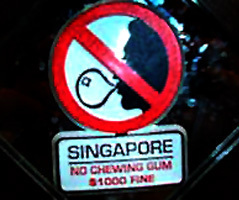
Singapore's government treats its subjects the way your parents treated you. You have been warned.
Do you think you would like to become a podcaster on Blubrry? Click here for the details on joining. Enter my promo code, HSEASIA, to let them know I sent you, and you will get the first month's hosting for free!
Support this podcast!
Visit the Patreon page to become a long-term supporter of the podcast!
Episode 103: Indonesia Under Suharto
Do you think you would like to become a podcaster on Blubrry? Click here for the details on joining. Enter my promo code, HSEASIA, to let them know I sent you, and you will get the first month's hosting for free!
Support this podcast!
Visit the Patreon page to become a long-term supporter of the podcast!
Episode 102: Western New Guinea, Forgotten War, Unwanted People
This episode goes all the way to the eastern extremity of Southeast Asia -- western New Guinea. Geographically speaking, it's really part of the South Pacific region of the world, but it has been considered part of Indonesia since the Dutch claimed it, nearly two hundred years ago. Now we will look at what has happened there since the Dutch handed over western New Guinea to Indonesia, in 1962. Can we call this the last Southeast Asian colony?
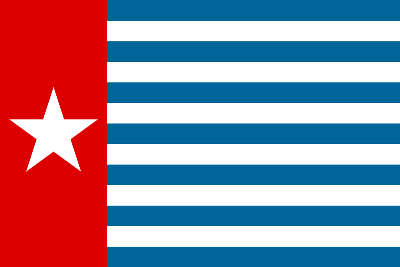
This is the Morning Star flag, the emblem of the OPM, or Free Papua Movement.
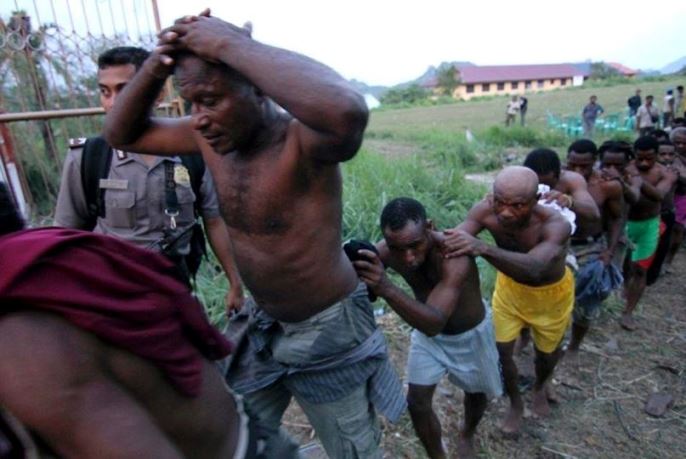
This photo from 2011 shows the Indonesian police hauling away participants in the Third Papuan Peoples Congress.

And here is Brin-Brin, the family pet I give a tribute to at the beginning of this episode.
Do you think you would like to become a podcaster on Blubrry? Click here for the details on joining. Enter my promo code, HSEASIA, to let them know I sent you, and you will get the first month's hosting for free!
Support this podcast!
And here is the Podcast Hall of Fame page, to honor those who have donated already!
Visit the Patreon page to become a long-term supporter of the podcast!
Episode 101: Burma, A Ne Win Situation
Do you think you would like to become a podcaster on Blubrry? Click here for the details on joining. Enter my promo code, HSEASIA, to let them know I sent you, and you will get the first month's hosting for free!
Support this podcast!
Visit the Patreon page to become a long-term supporter of the podcast!
Episode 100: The Philippines, A Dictatorship Made For Two

Imelda and Ferdinand Marcos.
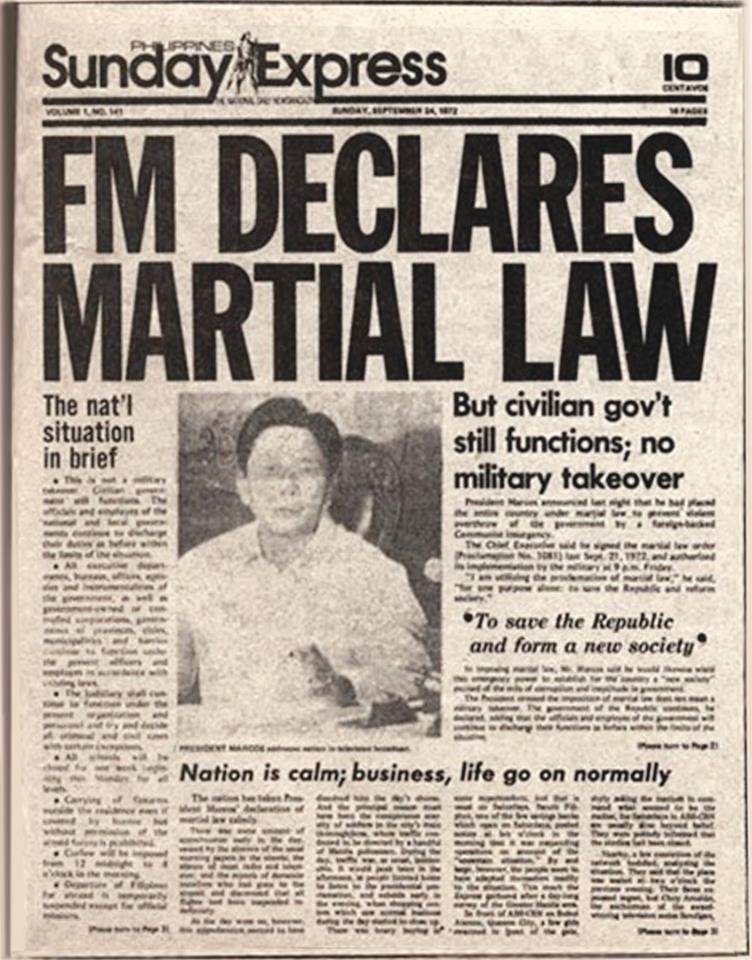
And here is a 1972 newspaper, announcing the declaration of martial law.
Do you think you would like to become a podcaster on Blubrry? Click here for the details on joining. Enter my promo code, HSEASIA, to let them know I sent you, and you will get the first month's hosting for free!
Support this podcast!
Visit the Patreon page to become a long-term supporter of the podcast!
Episode 99: Thailand Experiments With Revolution
Do you think you would like to become a podcaster on Blubrry? Click here for the details on joining. Enter my promo code, HSEASIA, to let them know I sent you, and you will get the first month's hosting for free!
Support this podcast!
Visit the Patreon page to become a long-term supporter of the podcast!
Episode 98: Malaysia and Singapore Get Organized
For this episode, the narrative goes to Malaya, which was last covered in Episode 69, and to Singapore and the British-ruled areas on the north side of Borneo. We will hear how Singapore became independent, and how Malaya became Malaysia.
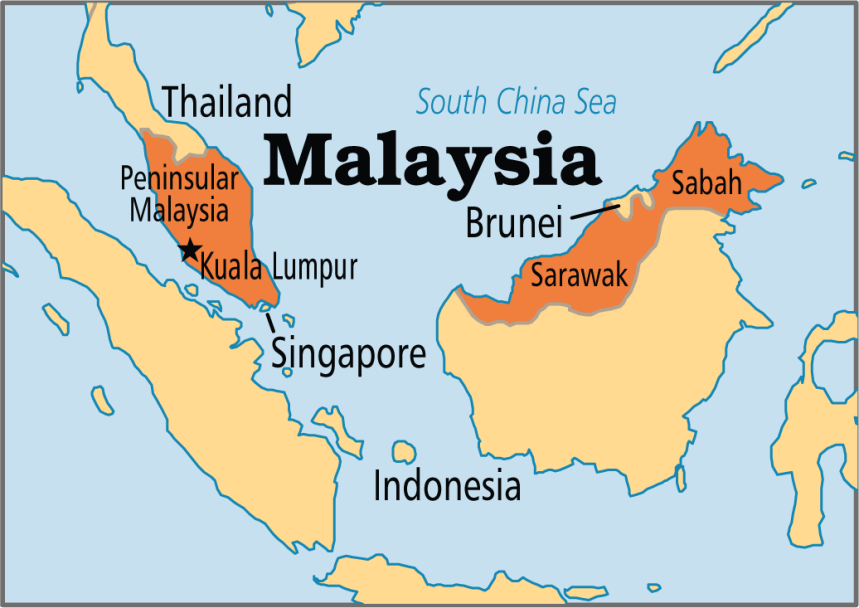
Here is a simple map of Malaysia showing all the places talked about in this episode, including Singapore and Brunei.
Do you think you would like to become a podcaster on Blubrry? Click here for the details on joining. Enter my promo code, HSEASIA, to let them know I sent you, and you will get the first month's hosting for free!
Support this podcast!
And here is the Podcast Hall of Fame page, to honor those who have donated already!
Visit the Patreon page to become a long-term supporter of the podcast!
Episode 97: Indonesia Under Sukarno
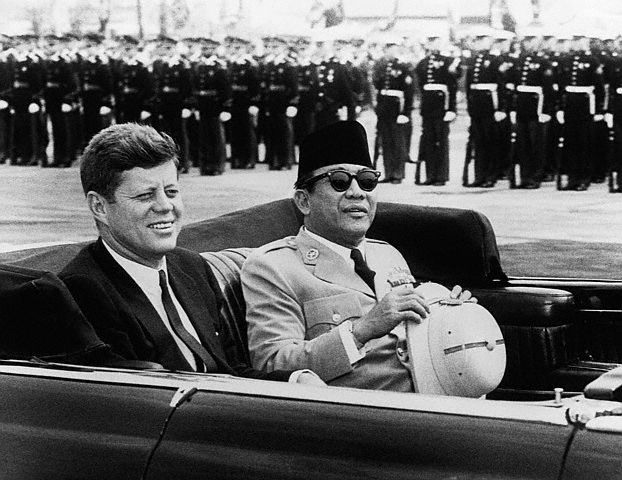
In 1961, Indonesia's President Sukarno visited Washington, D.C., to meet with John F. Kennedy. Both presidents were notorious womanizers, but while Sukarno was proud of it, in Kennedy's case the girl-chasing was kept secret until several years after his death.
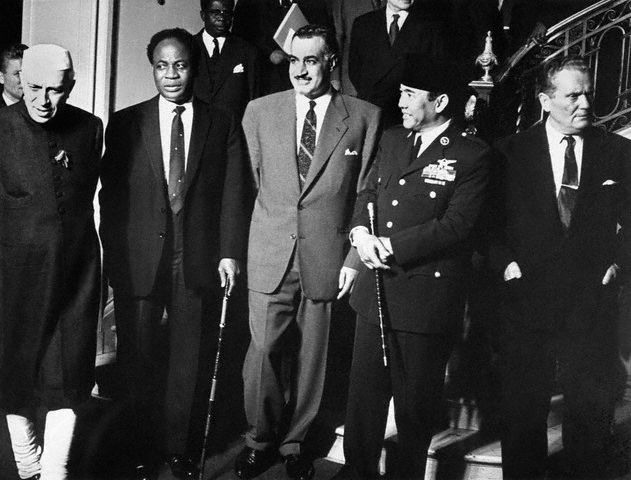
Under Sukarno, Indonesia helped get the Nonaligned Movement started, by hosting a conference of leaders from 29 neutral Asian and African countries, at Bandung on Java in 1955. Today we usually call the countries in the Nonaligned Movement the "Third World." This photo shows five leaders of the Nonaligned Movement. From left to right: India's Jawaharlal Nehru, Ghana's Kwame Nkrumah, Egypt's Gamal Abdel Nasser, Indonesia's Sukarno, Yugoslavia's Josip Broz Tito.
Do you think you would like to become a podcaster on Blubrry? Click here for the details on joining. Enter my promo code, HSEASIA, to let them know I sent you, and you will get the first month's hosting for free!
Support this podcast!
Visit the Patreon page to become a long-term supporter of the podcast!
Episode 96: The Second Indochina War, Part 23
Do you think you would like to become a podcaster on Blubrry? Click here for the details on joining. Enter my promo code, HSEASIA, to let them know I sent you, and you will get the first month's hosting for free!
Support this podcast!
Visit the Patreon page to become a long-term supporter of the podcast!
Episode 95: The Second Indochina War, Part 22
The previous episode of this podcast was a bit on the short side, so to make up for it, this episode is twice as long! Today we look at Vietnam and Cambodia, in 1973 and 1974. A cease-fire is signed for Vietnam in early 1973, which ends active American involvement in that country, but it fails to end the fighting. As for Cambodia, it takes two to make peace, and the communist Khmer Rouge don't even want to talk about it, so the Cambodian Civil War was a fight to the finish, with American bombers involved until August 1973. Tune in and listen to the action!
Do you think you would like to become a podcaster on Blubrry? Click here for the details on joining. Enter my promo code, HSEASIA, to let them know I sent you, and you will get the first month's hosting for free!
Support this podcast!
And here is the Podcast Hall of Fame page, to honor those who have donated already!
Visit the Patreon page to become a long-term supporter of the podcast!
Episode 94: The Second Indochina War, Part 21
This episode covers the war in Vietnam, also called the Second Indochina War, during 1972. North Vietnam launches a major offensive that is eventually defeated, thanks to American air power, but they are able to grab ten percent of South Vietnam's territory, and keep their soldiers in it afterwards. Meanwhile, the peace talks continue. The United States and North Vietnam finally reach an agreement, but the talks are interrupted by two major US bombing campaigns against North Vietnam, leading many to think that peace was forced upon the North Vietnamese. What will that mean when the cease-fire is signed in the following year?
Do you think you would like to become a podcaster on Blubrry? Click here for the details on joining. Enter my promo code, HSEASIA, to let them know I sent you, and you will get the first month's hosting for free!
Support this podcast!
And here is the Podcast Hall of Fame page, to honor those who have donated already!
Visit the Patreon page for long-term supporters of the podcast!
Episode 93: The Second Indochina War, Part 20
Better late than never, as the saying goes! Sorry for the delays. This episode covers the war in Vietnam during 1970 and 1971. Also covered are events in the United States in the same time that affected the war: more antiwar protests, and the publication of the Pentagon Papers.
Do you think you would like to become a podcaster on Blubrry? Click here for the details on joining. Enter my promo code, HSEASIA, to let them know I sent you, and you will get the first month's hosting for free!
Support this podcast!
And here is the Podcast Hall of Fame page, to honor those who have donated already!
Visit the Patreon page for long-term supporters of the podcast!
Finally, here is a link to the presentation I gave at the Intelligent Speech Conference, on June 27, 2020.
An Important Announcement
Today the podcast is four years old. Listen for a special message on where the podcast is going from here.
Episode 92: The Second Indochina War, Part 19
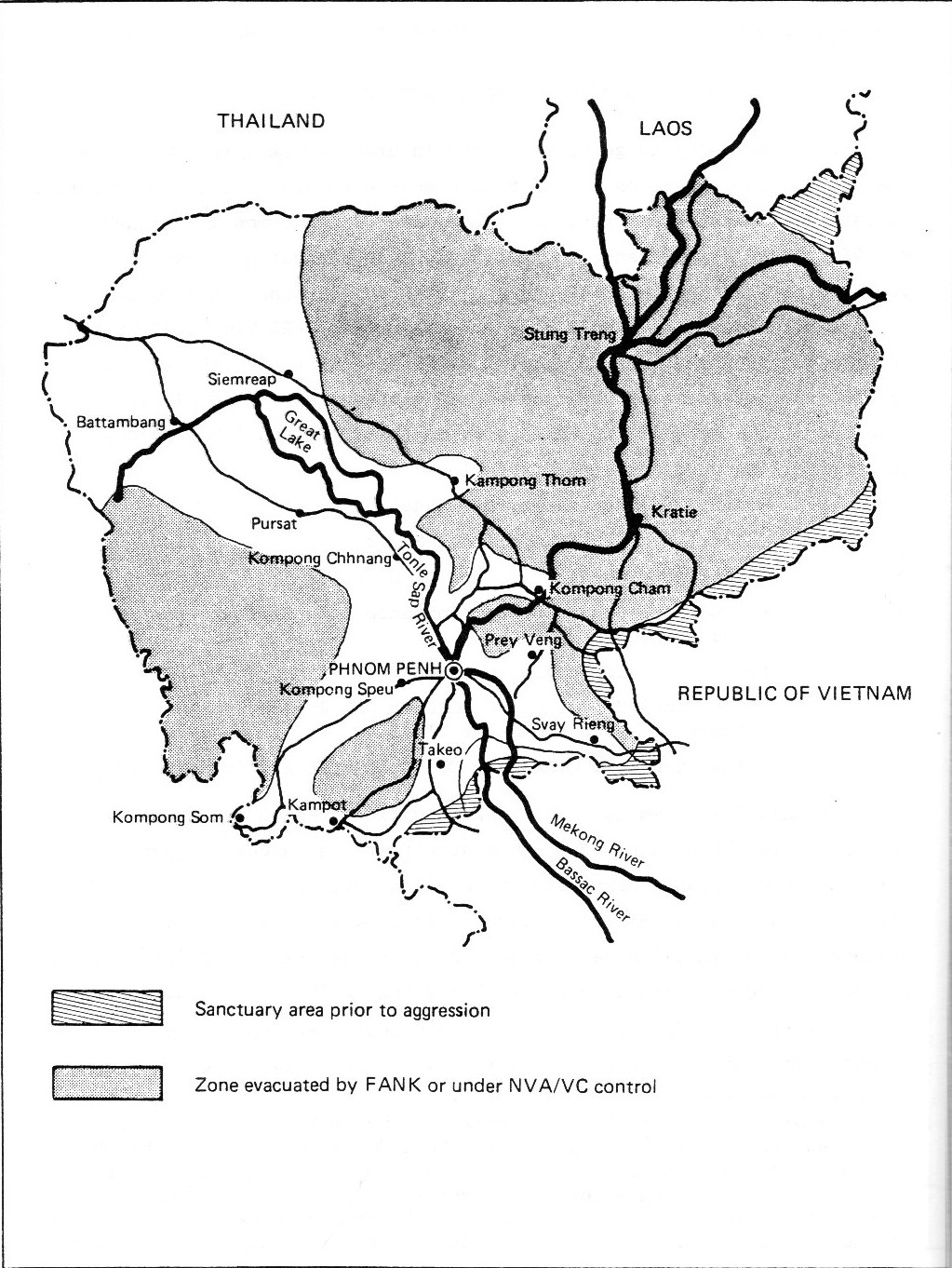
The North Vietnamese-backed invasion of Cambodia began in late March 1970, and was halted in August 1970. This map shows communist-controlled areas (grey) and government-controlled areas (white) in August 1970. There were few changes to this for the next two and a half years, until early 1973. The grey areas to the west of Phnom Penh were taken by the Khmer Rouge, without North Vietnamese help. Also, the town of Kratie became the new Viet Cong headquarters, after it was captured.
Do you think you would like to become a podcaster on Blubrry? Click here for the details on joining. Enter my promo code, HSEASIA, to let them know I sent you, and you will get the first month's hosting for free!
Support this podcast!
Finally, visit the Patreon page for long-term supporters of the podcast!
Episode 91: The Second Indochina War, Part 18
Do you think you would like to become a podcaster on Blubrry? Click here for the details on joining. Enter my promo code, HSEASIA, to let them know I sent you, and you will get the first month's hosting for free!
Support this podcast!
Finally, visit the Patreon page for long-term supporters of the podcast!
Episode 90: The Second Indochina War, Part 17
Do you think you would like to become a podcaster on Blubrry? Click here for the details on joining. Enter my promo code, HSEASIA, to let them know I sent you, and you will get the first month's hosting for free!
Support this podcast!
Finally, visit the Patreon page for long-term supporters of the podcast!
Episode 89: The Second Indochina War, Part 16
This episode covers events in the Second Indochina War, also called the Vietnam War, in 1969. In the United States there is a new president, Richard M. Nixon, and he starts the process of removing the Americans from the war, while on the streets of American cities, antiwar protests reach their peak. And over in North Vietnam, we say goodbye to Ho Chi Minh, who has been an important character in the narrative since Episode 35.
Do you think you would like to become a podcaster on Blubrry? Click here for the details on joining. Enter my promo code, HSEASIA, to let them know I sent you, and you will get the first month's hosting for free!
Support this podcast!
And here is the Podcast Hall of Fame page, to honor those who have donated already!
Finally, visit the Patreon page for long-term supporters of the podcast!
Episode 88: The Second Indochina War, Part 15
Do you think you would like to become a podcaster on Blubrry? Click here for the details on joining. Enter my promo code, HSEASIA, to let them know I sent you, and you will get the first month's hosting for free!
Support this podcast!
Finally, visit the new Patreon page for long-term supporters of the podcast!
Episode 87: The Second Indochina War, Part 14
Do you think you would like to become a podcaster on Blubrry? Click here for the details on joining. Enter my promo code, HSEASIA, to let them know I sent you, and you will get the first month's hosting for free!
Support this podcast!
Finally, visit the new Patreon page for long-term supporters of the podcast!
Episode 86: The Second Indochina War, Part 13
Do you think you would like to become a podcaster on Blubrry? Click here for the details on joining. Enter my promo code, HSEASIA, to let them know I sent you, and you will get the first month's hosting for free!
Support this podcast!
Finally, visit the new Patreon page for long-term supporters of the podcast!
Episode 85: Question and Answer Session 3
Do you think you would like to become a podcaster on Blubrry? Click here for the details on joining. Enter my promo code, HSEASIA, to let them know I sent you, and you will get the first month's hosting for free!
Support this podcast!
Finally, visit the Patreon page, for long-term supporters of the podcast!
Episode 84: The Second Indochina War, Part 12
Do you think you would like to become a podcaster on Blubrry? Click here for the details on joining. Enter my promo code, HSEASIA, to let them know I sent you, and you will get the first month's hosting for free!
Support this podcast!
Finally, visit the new Patreon page for long-term supporters of the podcast!
Episode 83: The Second Indochina War, Part 11
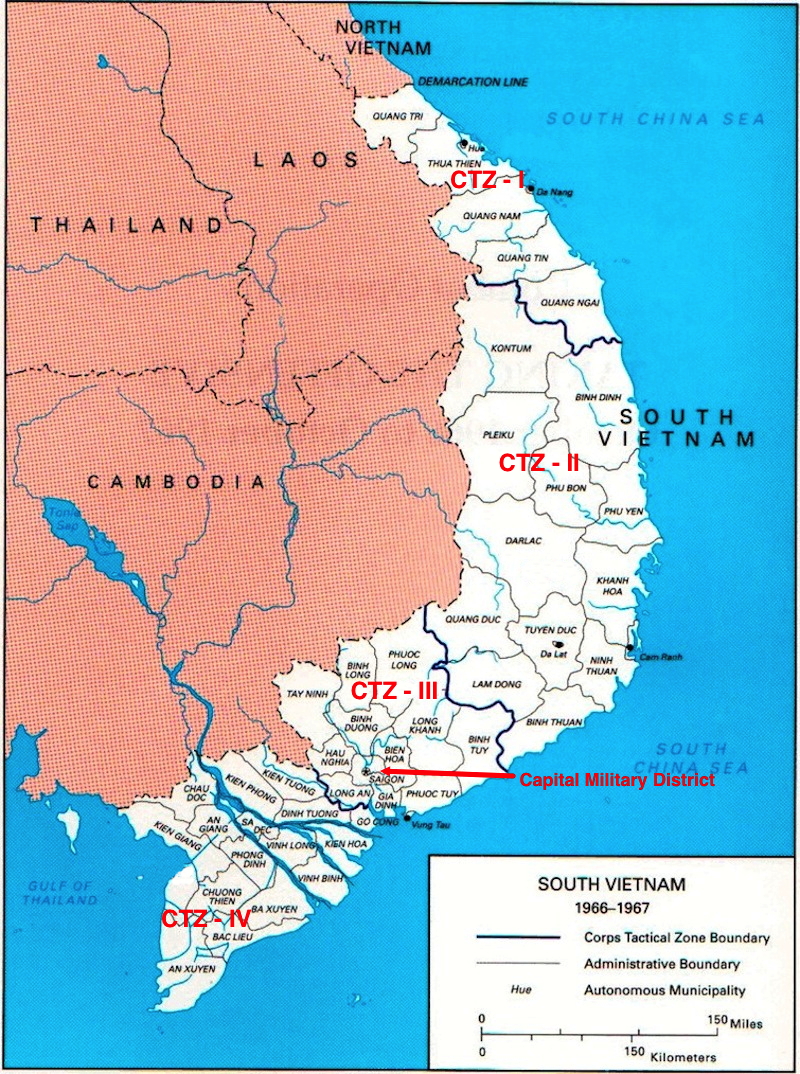
During the war, South Vietnam was divided into four military districts, called "Corps Tactical Zones" (CTZs) by Americans. Here is a map showing the borders between the zones. The Buddhist uprising in this episode took place in Zone 1, and started over the firing of the general in charge of the army (ARVN) in that zone. Source: http://720mpreunion.org/history/project_vietnam/maps/Corps_Tactical_Zones.html
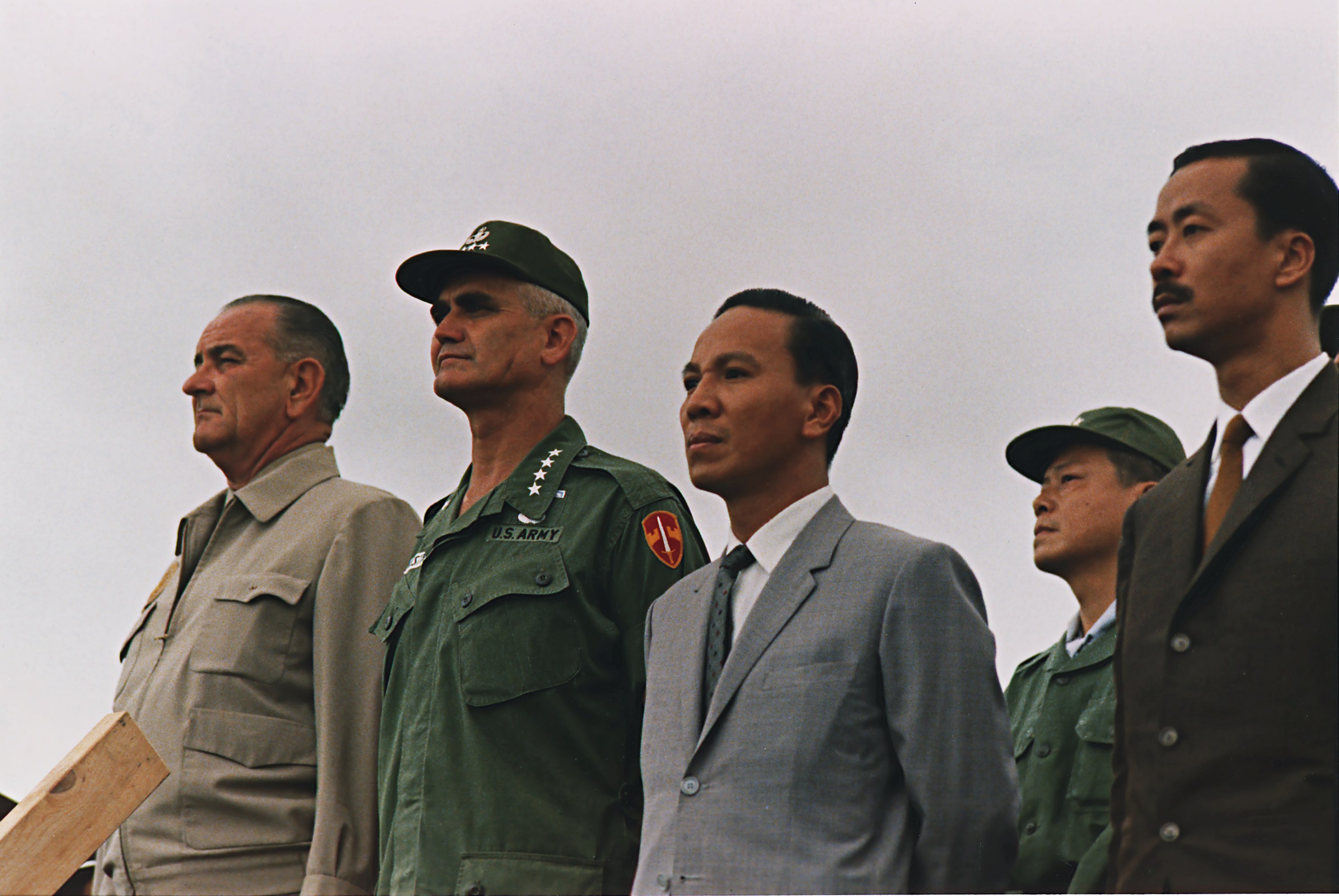
On October 26, 1966, US President Lyndon B. Johnson ("LBJ") visited American troops at Cam Ranh Bay. This was the first of two visits he made to South Vietnam during his presidency. The photo shows American and South Vietnamese leaders together. From left to right: Johnson, General William C. Westmoreland, Nguyen Van Thieu, an unknown South Vietnamese official, and Nguyen Cao Ky.
Do you think you would like to become a podcaster on Blubrry? Click here for the details on joining. Enter my promo code, HSEASIA, to let them know I sent you, and you will get the first month's hosting for free!
Support this podcast!
Finally, visit the new Patreon page for long-term supporters of the podcast!
Episode 82: The Second Indochina War, Part 10
Today we continue the ongoing narrative about the Second Indochina War in Vietnam, covering events for the rest of 1965, and culminating with the battle of Ia Drang.
Do you think you would like to become a podcaster on Blubrry? Click here for the details on joining. Enter my promo code, HSEASIA, to let them know I sent you, and you will get the first month's hosting for free!
Support this podcast!
And here is the Podcast Hall of Fame page, to honor those who have donated already!
Finally, visit the new Patreon page for long-term supporters of the podcast!
Episode 81: The Second Indochina War, Part 9
Happy New Year, and here is the first episode for 2020! In Episode 81 the first American combat troops come to Vietnam, only to find that their visit will not be a short one, and that a lot more Americans will have to join them.
Do you think you would like to become a podcaster on Blubrry? Click here for the details on joining. Enter my promo code, HSEASIA, to let them know I sent you, and you will get the first month's hosting for free!
Support this podcast!
And here is the new Podcast Hall of Fame page, to honor those who have donated already!
Episode 80: The Second Indochina War, Part 8
Do you think you would like to become a podcaster on Blubrry? Click here for the details on joining. Enter my promo code, HSEASIA, to let them know I sent you, and you will get the first month's hosting for free!
Support this podcast!
Episode 79: The Second Indochina War, Part 7
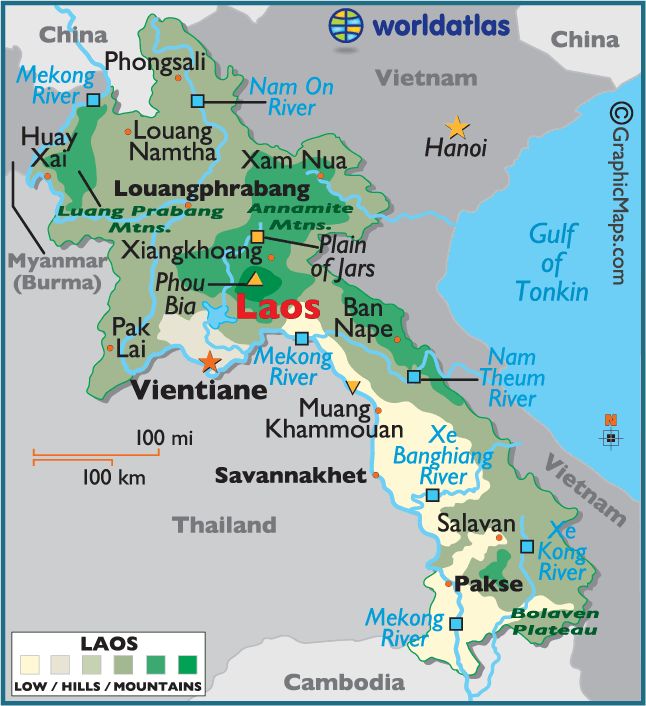
Here is the map I posted with Episode 74, shared again to help with the geography. Tchepone, the objective of the 1971 South Vietnamese invasion, is near the source of the Xe Banghiang River. Long Tieng is not shown; that Hmong community and CIA base is near Xiangkhoang. Source: WorldAtlas.com.
Do you think you would like to become a podcaster on Blubrry? Click here for the details on joining. Enter my promo code, HSEASIA, to let them know I sent you, and you will get the first month's hosting for free!
Support this podcast!
Episode 78: The Second Indochina War, Part 6
After a two-episode break, we are going back to the narrative about the Second Indochina War in Laos, this time covering events from 1964 to 1968, with special emphasis on the battles for Nam Bac Valley and Lima Site 85.
Do you think you would like to become a podcaster on Blubrry? Click here for the details on joining. Enter my promo code, HSEASIA, to let them know I sent you, and you will get the first month's hosting for free!
Support this podcast!
Episode 77: What Buddhism is All About
This is another special episode, prompted because a donor to the podcast asked three questions that I should have answered two or three years ago. May you find the answers enlightening (pun intended). You may want to go back and re-listen to the early episodes that discussed Buddhism's impact on Southeast Asia, especially Episodes 2, 3, 5, 6, and 7, after hearing this.
https://www.youtube.com/watch?v=KoeeIiCpbcw
Here is a documentary I watched forty years ago about the Torajas, a tribe living on the eastern Indonesian island of Sulawesi. Because of the work of Dutch missionaries, most of the Torajas converted to Christianity in the first half of the twentieth century, and because this is Indonesia, the world’s largest Moslem country, a few have converted to Islam, but a core group in the tribe still practice the old-time animism, which involves water buffalo sacrifices and an elaborate cult of the dead. I am posting the link because the Torajas are mentioned in this episode.
Do you think you would like to become a podcaster on Blubrry? Click here for the details on joining. Enter my promo code, HSEASIA, to let them know I sent you, and you will get the first month's hosting for free!
Support this podcast!
Episode 76: Monsters of Southeast Asia

Among the monsters Southeast Asians believe in, one of the most hideous appears as a woman's head with an assortment of internal organs hanging underneath. She goes by many names; Cambodians calls her the Ap, Laotians calls her the Kasu, Thais calls her the Krasue, and Malaysians calls her the Penanggalan, while the Philippines has a similar monster called the Manananggal. Source: Infogalactic.com.
Do you think you would like to become a podcaster on Blubrry? Click here for the details on joining. Enter my promo code, HSEASIA, to let them know I sent you, and you will get the first month's hosting for free!
Support this podcast!
Episode 75: The Second Indochina War, Part 5
Do you think you would like to become a podcaster on Blubrry? Click here for the details on joining. Enter my promo code, HSEASIA, to let them know I sent you, and you will get the first month's hosting for free!
Support this podcast!
Episode 74: The Second Indochina War, Part 4
Because the previous three episodes were focused on just Vietnam, it is now time to go west and catch up on the Second Indochina War in Laos. This episode covers the history of Laos from 1954 to 1962.
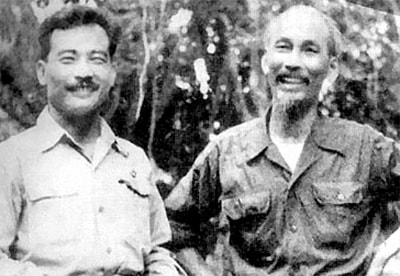
The communists in Laos, the Pathet Lao, would have gotten nowhere without lots of help from the communists in Vietnam. As a result, the front man for the Pathet Lao, Prince Souphanouvong, spent much of his time in North Vietnam. This picture shows him with Ho Chi Minh.

Just in case you're not familiar with the geography, here's a map of the country, courtesy of WorldAtlas.com. All the places I mention are shown here. You can also see how little flat land the country has -- just the white areas along the Mekong River, plus the Plain of Jars.
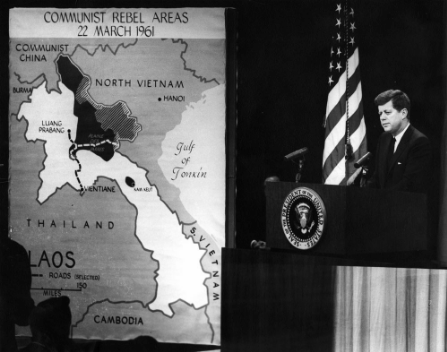
In a press conference on March 23, 1961, US President John F. Kennedy made the first call for a cease-fire in Laos. The black and grey areas on the map indicate the territories the Pathet Lao had taken up to that date; over the next month and a half, North Vietnam would help them take the rest of the land along the eastern border.
Do you think you would like to become a podcaster on Blubrry? Click here for the details on joining. Enter my promo code, HSEASIA, to let them know I sent you, and you will get the first month's hosting for free!
Support this podcast!
Episode 73: The Second Indochina War, Part 3
Do you think you would like to become a podcaster on Blubrry? Click here for the details on joining. Enter my promo code, HSEASIA, to let them know I sent you, and you will get the first month's hosting for free!
Support this podcast!
Episode 72: The Second Indochina War, Part 2
Do you think you would like to become a podcaster on Blubrry? Click here for the details on joining. Enter my promo code, HSEASIA, to let them know I sent you, and you will get the first month's hosting for free!
Support this podcast!
Episode 71: The Second Indochina War, Part 1
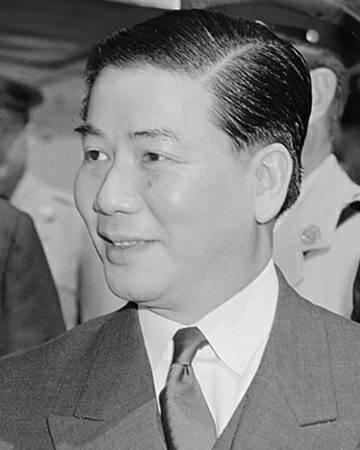
The main character in today's episode is Ngo Dinh Diem, the president of South Vietnam from 1955 to 1963. Here is his picture.
Do you think you would like to become a podcaster on Blubrry? Click here for the details on joining. Enter my promo code, HSEASIA, to let them know I sent you, and you will get the first month's hosting for free!
Support this podcast!
Episode 70: The Hill Tribes of Vietnam and Laos
Today is the first day of a new month, Canada's 152nd birthday, and the third anniversary of the podcast! So naturally we have a special episode for today. This time, instead of the usual historical narrative, we will meet the hill tribes of Vietnam and Laos, also called the Degar or Montagnards. There are 54 ethnic groups in Vietnam, and 160 in Laos, but most of the time we only hear from the dominant majorities, the Vietnamese and the Lao. Therefore this episode will give equal time to the other groups.
And here is a link to the Lithophone video mentioned in the episode. This rocks -- literally!
https://www.youtube.com/watch?reload=9&v=trTDTCixA_c
Do you think you would like to become a podcaster on Blubrry? Click here for the details on joining. Enter my promo code, HSEASIA, to let them know I sent you, and you will get the first month's hosting for free!
Support this podcast!
Episode 69: The Malayan Emergency
Do you think you would like to become a podcaster on Blubrry? Click here for the details on joining. Enter my promo code, HSEASIA, to let them know I sent you, and you will get the first month's hosting for free!
Support this podcast!
Episode 68: The First Indochina War, Part 5
Today we will wrap up the First Indochina War by covering the showdown which proved to the French that they couldn't stay in Vietnam anymore -- the battle of Dien Bien Phu!
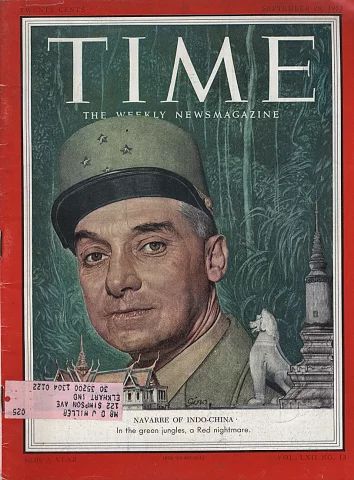
Over the course of the war, the French had seven generals commanding their forces. The last of those generals was Henri Navarre, who led from May 1953 to the end of the war in mid-1954. Here he is, from a Time Magazine cover dated December 28, 1953. His job was to stabilize the situation so that France could negotiate from a position of strength (by this time, the French no longer expected to win the war), but instead his strategy led to the disastrous battle of Dienbienphu.
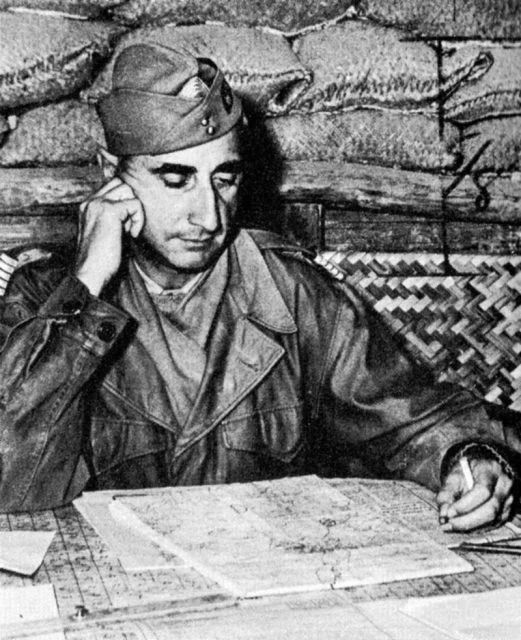
When the French established their base at Dien Bien Phu, they put a dashing tank commander, Colonel Christian de Castries, in charge of it. Rumor has it that de Castries left gambling debts and heartbroken mistresses back in France. Actually he proved to be a poor choice, because he was experienced in mobile warfare, and here his job was to defend a fixed position. During the battle he spent most of his time in his bunker, and was rarely seen by the troops. The Viet Minh captured de Castries on the last day of the siege, and held him prisoner for four months.
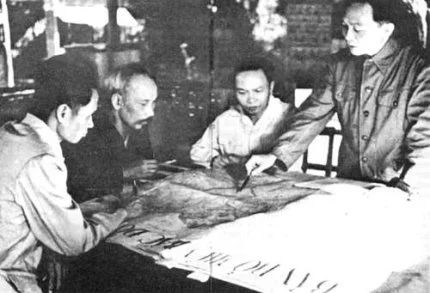
Now from the other side, here are the Viet Minh leaders planning their strategy for Dien Bien Phu. From left to right: Pham Van Dong, Ho Chi Minh, Truong Chinh, Vo Nguyen Giap.
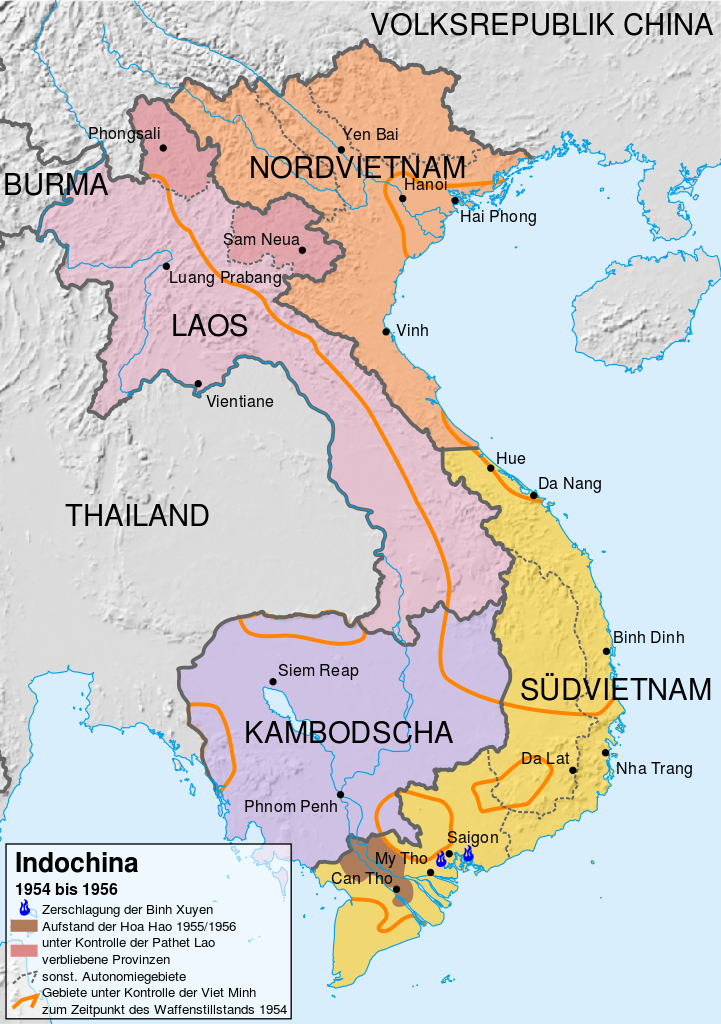
Finally, here is a map showing Indochina at the end of the First Indochina War, in July 1954. The orange lines mark the limits of the areas that were under communist control, or at least where the communists had more influence than the French and the pro-French governments that had been set up in each country. By "communists," we mean not only the Viet Minh in Vietnam, but also the Pathet Lao in Laos, and the United Issarak Front in Cambodia. The dark pink areas in Laos mark the two provinces the Pathet Lao gained control over in 1953. According to the terms of the Geneva Accords, the communists got all of North Vietnam (called Nordvietnam on this German language map), but they had to give back everything they had taken in South Vietnam, Laos and Cambodia. The areas marked blue and brown near Saigon are local uprisings that happened after 1954; they will be discussed in a future podcast episode.
Do you think you would like to become a podcaster on Blubrry? Click here for the details on joining. Enter my promo code, HSEASIA, to let them know I sent you, and you will get the first month's hosting for free!
Support this podcast!
Episode 67: The First Indochina War, Part 4
For Part 4 in our series on the First Indochina War, this episode covers the events of 1952 and most of 1953. We will look at the battles in northwest Vietnam, as the Viet Minh invade this area. Then we will see the opening of a second front in Laos, which will start an on-and-off civil war that will last for the next 22 years. Finally, we will learn how Laos and Cambodia achieved full independence from France.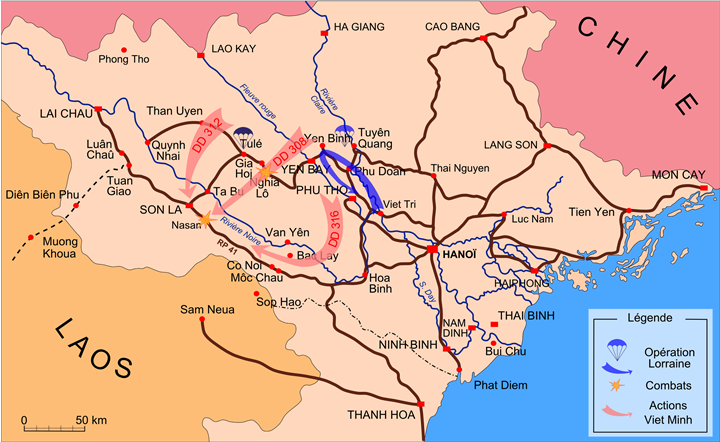
Today's map shows the campaigns in northern Vietnam (then called Tonkin) in 1952. The Viet Minh (pink arrows) advanced from the Red River valley to the Black River valley. By the end of 1952 they had also reached the western border, making it possible for them to invade Laos in 1953. The blue arrow marks the French counterattack, Operation Lorraine; it turned back before it captured its main objective, the Viet Minh supply base at Yen Binh. However, the French garrison surrounded at Na San was able to resist all attacks after the enemy surrounded it, until it was evacuated in August 1953. Source: offbeathistory.files.wordpress.com
And for those who missed it last time, here is the link to the story about homo luzonensis, the cave man found in the Philippines.
A new hominid species has been found in a Philippine cave, fossils suggest
Do you think you would like to become a podcaster on Blubrry? Click here for the details on joining. Enter my promo code, HSEASIA, to let them know I sent you, and you will get the first month's hosting for free!
Support this podcast!
Episode 66: The First Indochina War, Part 3
Today's episode is the third in our series about the Indochina Wars. Here we will look at the campaigns of 1951. In response to the successful Viet Minh (Vietnamese Communist) offensive of 1950, the French send in their best general, Jean de Lattre de Tassigny. It was only during the eleven months when de Lattre was in command (December 1950 - November 1951) that the French felt they had a good chance of winning.
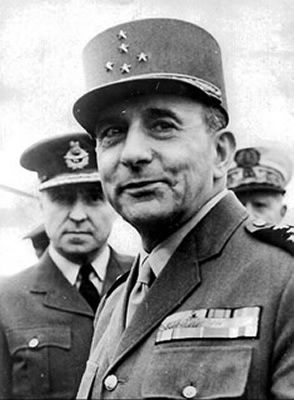
Jean de Lattre de Tassigny. The Americans called him "D.D.T.," and the French called him Roi Jean (King John).
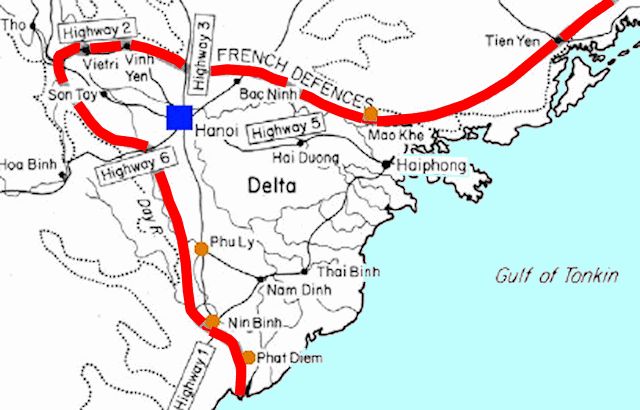
This map shows a close-up of the Red River delta, in northern Vietnam, 1951. The orange dots mark spots where the Viet Minh made unsuccessful invasions of the delta. Another invasion, which isn't marked, took place at Vinh Yen, northwest of Hanoi. To stop these incursions, General Jean de Lattre de Tassigny built a massive defensive barrier, shown by the red line. This barrier was called the "De Lattre Line"; it kept Hanoi, Haiphong and the delta in French hands for the rest of the First Indochina War, but it also tied down more than half of the French army in Vietnam, because they were needed to man the line. Source: Globalsecurity.org
And here is the story about homo luzonensis, the cave man found in the Philippines.
A new hominid species has been found in a Philippine cave, fossils suggest
Do you think you would like to become a podcaster on Blubrry? Click here for the details on joining. Enter my promo code, HSEASIA, to let them know I sent you, and you will get the first month's hosting for free!
Support this podcast!
Episode 65: The First Indochina War, Part 2
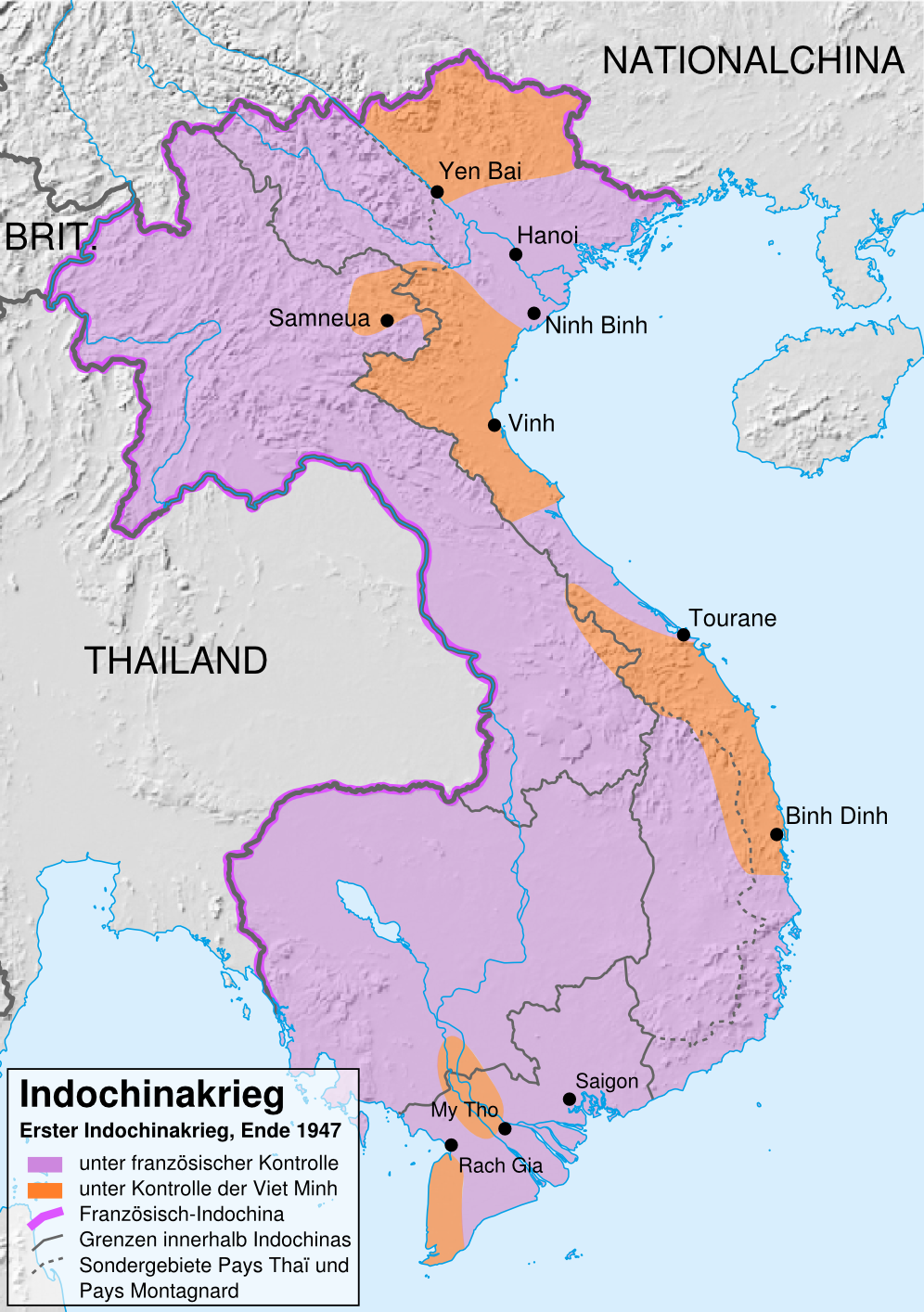
Here is a map of the First Indochina War, not long after it started, in 1947. The French controlled the violet areas, while the Viet Minh controlled the areas colored reddish-orange. For nearly three years after this -- in 1948, 1949 and early 1950 -- the front lines between the two sides barely moved at all. For that reason, one of the names given for this conflict is "the Quicksand War."
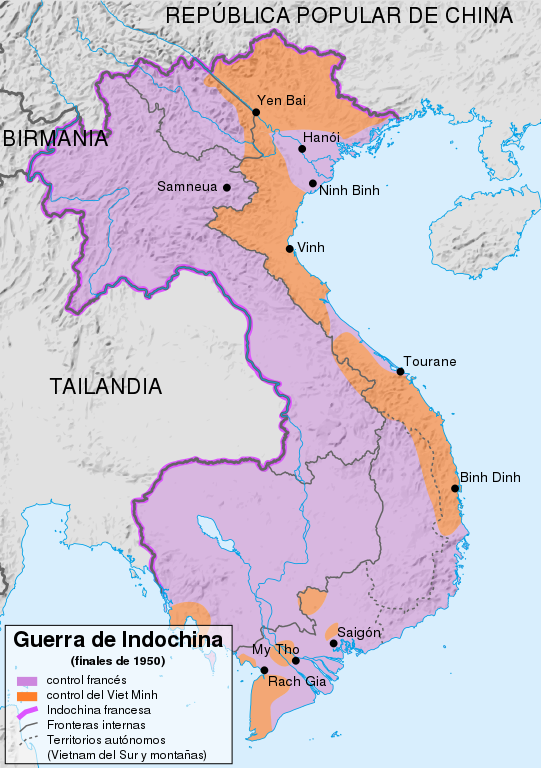
Here is another map of the First Indochina War, showing the situation at the end of 1950. As with the 1947 map, the French control the violet areas, and the Communists (mostly Viet Minh) control the reddish-orange areas. The biggest change from last time is that the Viet Minh have captured northeast Vietnam, and are now putting the squeeze on the Red River delta.
Do you think you would like to become a podcaster on Blubrry? Click here for the details on joining. Enter my promo code, HSEASIA, to let them know I sent you, and you will get the first month's hosting for free!
Support this podcast!
Episode 64: The First Indochina War, Part 1
This is the first in what will be a series of episodes about the Indochina Wars, which afflicted Vietnam, Cambodia and Laos for more than forty years (1945-1989). Today we introduce the scene and the characters in 1945-46, between the end of World War II and the beginning of what is officially called the First Indochina War.
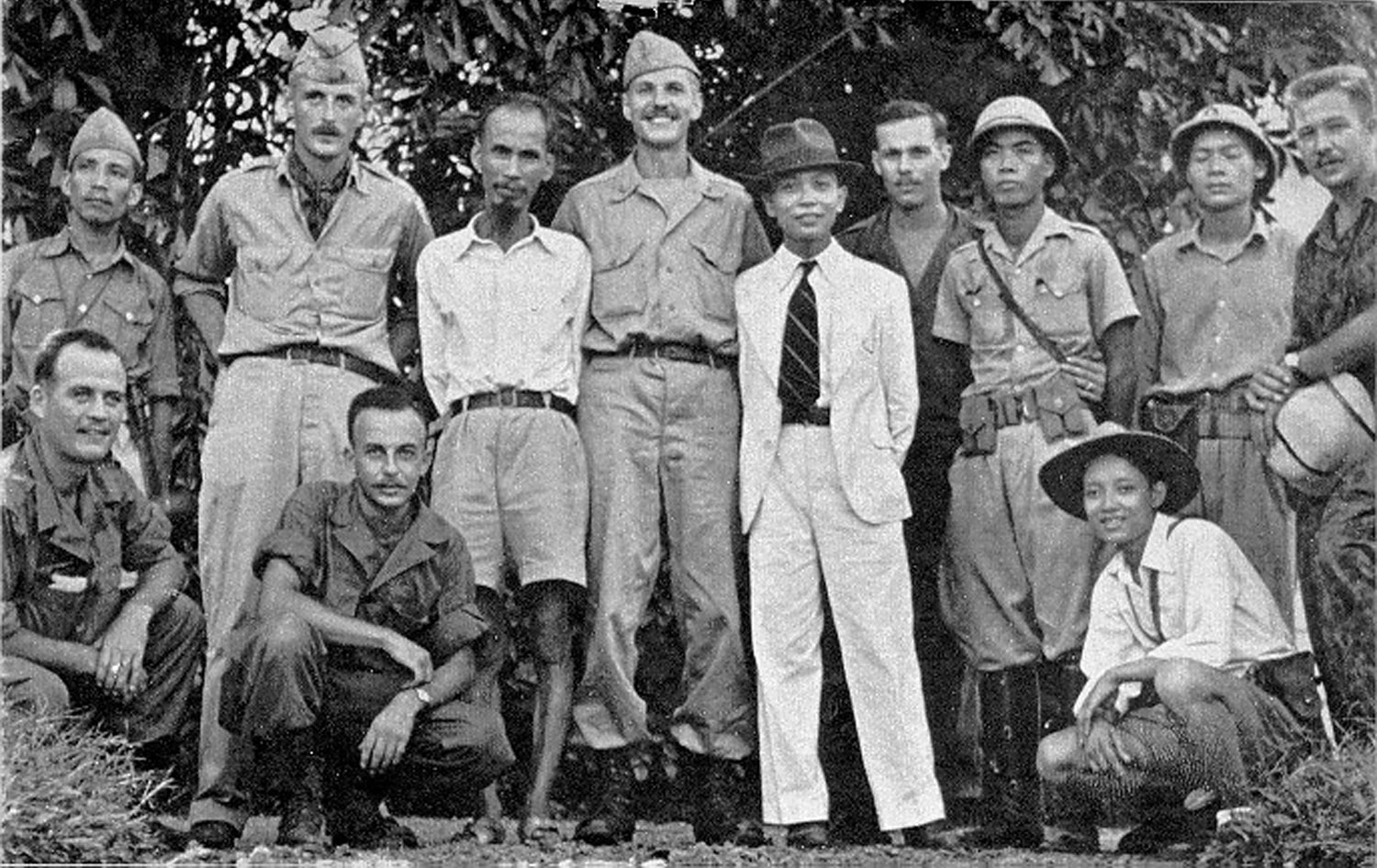
During World War II, The United States gave aid to anyone fighting the Axis powers (Germany, Italy and Japan), and that included communists. As a result, the US Army's intelligence agency, the Office of Strategic Services (OSS), sent a team into Vietnam in July 1945, and they gave the Viet Minh equipment and guerrilla training. Among those standing in this picture, Ho Chi Minh is the third from the left. The individual wearing a tie is Vo Nguyen Giap, the Viet Minh military commander. Between Ho and Giap is the OSS team leader, Major Allison Thomas.
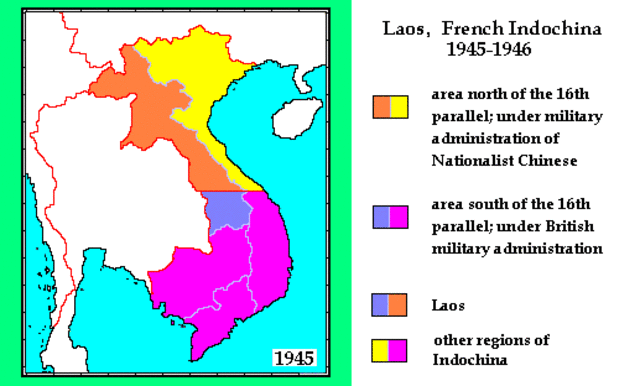
Indochina was temporarily partitioned in late 1945 and early 1946, until the French returned to re-occupy their colony. Judging from the western border's location, this must have happened before Thailand gave back the Laotian and Cambodian provinces it took in 1941.
Do you think you would like to become a podcaster on Blubrry? Click here for the details on joining. Enter my promo code, HSEASIA, to let them know I sent you, and you will get the first month's hosting for free!
Support this podcast!
Episode 63: Modern Burmese Birth Pangs
Now for this episode, we will learn about how modern Burma (Myanmar since 1989) became independent. Although the Burmese do not have to fight the British anymore, their troubles will come in bunches.
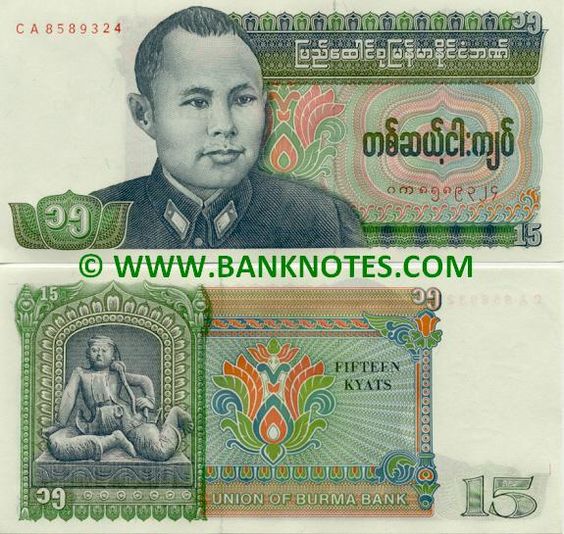
Back with Episode 32, I posted a picture of a Burmese 90 kyat note, featuring a picture of the nationalist Saya San. Now here is a 15 kyat note (1986 edition), showing Aung San. Because Aung San is considered the father of modern Myanmar/Burma, and he is the real-life father of Aung San Suu Kyi, his picture has appeared on several denominations, including the 1 kyat, 35 kyat, and 100 kyat bills.
Do you think you would like to become a podcaster on Blubrry? Click here for the details on joining. Enter my promo code, HSEASIA, to let them know I sent you, and you will get the first month's hosting for free!
Support this podcast!
Episode 62: The Hukbalahap Rebellion
Do you think you would like to become a podcaster on Blubrry? Click here for the details on joining. Enter my promo code, HSEASIA, to let them know I sent you, and you will get the first month's hosting for free!
Support this podcast!
Episode 61: Who Killed the King of Siam?
I hope you had a good time with the special person in your life on Valentines Day -- because that was yesterday. Now it is time to listen to the latest episode of the podcast! Today we look at Thailand between 1945 and 1957, as the Unconquered Kingdom seeks its place in the postwar, post-colonial world. Also, we learn of the unsolved mystery around the assassination of King Rama VIII.
Do you think you would like to become a podcaster on Blubrry? Click here for the details on joining. Enter my promo code, HSEASIA, to let them know I sent you, and you will get the first month's hosting for free!
Support this podcast!
Episode 60: The Indonesian War of Independence
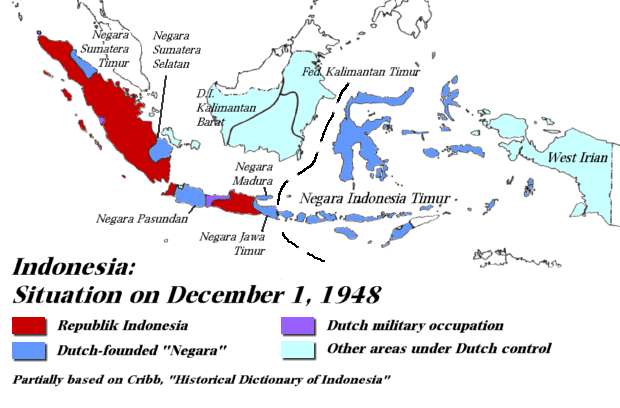
Here is a map of the situation in the Dutch East Indies, between the Renville Agreement and Operation Crow. Source: Gimonca.com.
Do you think you would like to become a podcaster on Blubrry? Click here for the details on joining. Enter my promo code, HSEASIA, to let them know I sent you, and you will get the first month's hosting for free!
Support this podcast!
Episode 59: Nationalism Triumphant
Do you think you would like to become a podcaster on Blubrry? Click here for the details on joining. Enter my promo code, HSEASIA, to let them know I sent you, and you will get the first month's hosting for free!
Support this podcast!
Episode 58: The End of World War II
Do you think you would like to become a podcaster on Blubrry? Click here for the details on joining. Enter my promo code, HSEASIA, to let them know I sent you, and you will get the first month's hosting for free!
Support this podcast!
Episode 57: Talking With Two Guys in Singapore
Today we take a break from the narrative, because I have been interviewed again. This time it was done by the two hosts of a new Singapore-based podcast, called "We Don't Mean to Dwell, But . . ." Check it out, and if you would like to listen to more episodes from this podcast, click on the link below:
http://www.dontmeantodwell.com
Do you think you would like to become a podcaster on Blubrry? Click here for the details on joining. Enter my promo code, HSEASIA, to let them know I sent you, and you will get the first month's hosting for free!
Support this podcast!
Episode 56: The Forgotten War in Burma, Part 4
With this episode we finish the podcast narrative about World War II in Burma, or as we now call it, Myanmar. Here the British and the Japanese fight for the city of Rangoon, modern day Yangon. In the middle of the battle the rainy season begins, which forces both sides to call a halt to most of the fighting. But in 1945, the war will end before the rainy season does.
Do you think you would like to become a podcaster on Blubrry? Click here for the details on joining. Enter my promo code, HSEASIA, to let them know I sent you, and you will get the first month's hosting for free!
Support this podcast!
Episode 55: The Forgotten War in Burma, Part 3
Today we return to Burma, now called Myanmar, to hear about the efforts of the Allies, especially the British, to take back this land during World War II. Also, the Ledo Road will be finished, and the Burma Road will be recovered.
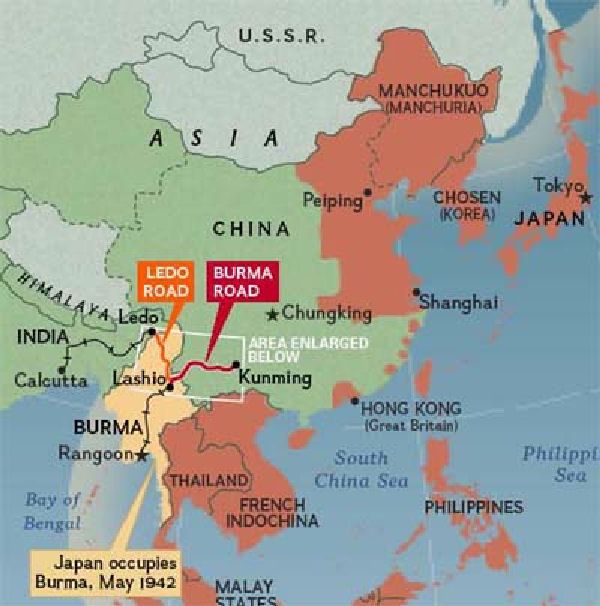
A map of the Far East during the war, showing the two roads mentioned above.
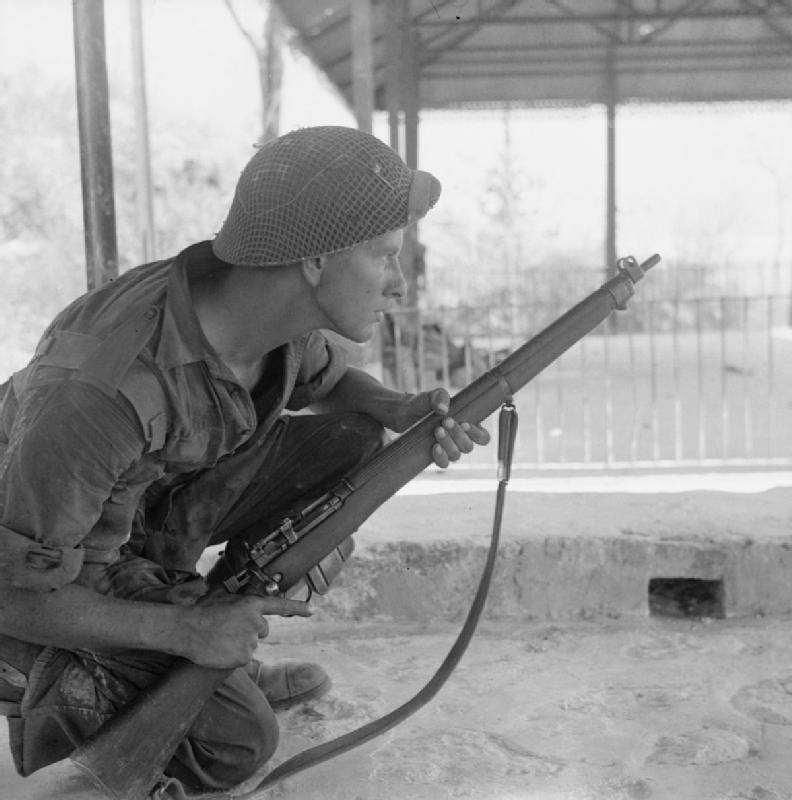
A British soldier at Fort Dufferin, during the battle of Mandalay.
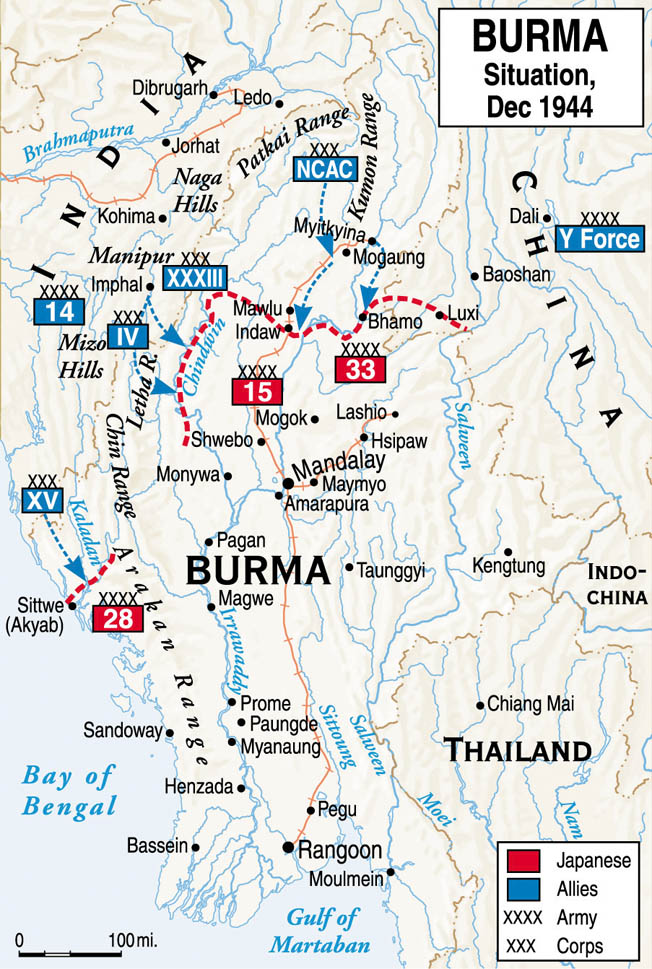
This map shows where the units were located before the real fighting started, in December 1944. The Allied units are blue, while red marks the Japanese units. Source: warfarehistorynetwork.com.
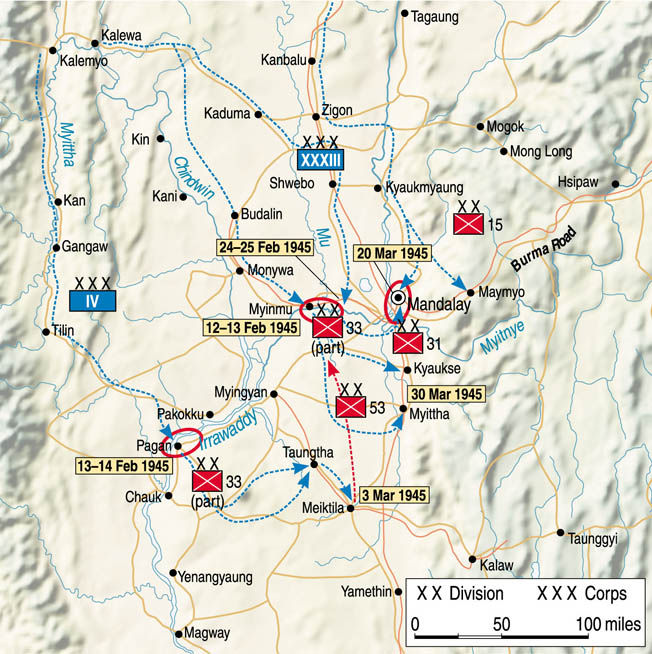
And here is a map to follow the battle of Mandalay and Meiktila. Again the Allies are blue and the Japanese are red. Source: warfarehistorynetwork.com.
Do you think you would like to become a podcaster on Blubrry? Click here for the details on joining. Enter my promo code, HSEASIA, to let them know I sent you, and you will get the first month's hosting for free!
Support this podcast!
Episode 54: The Liberation of the Philippines, Part 4
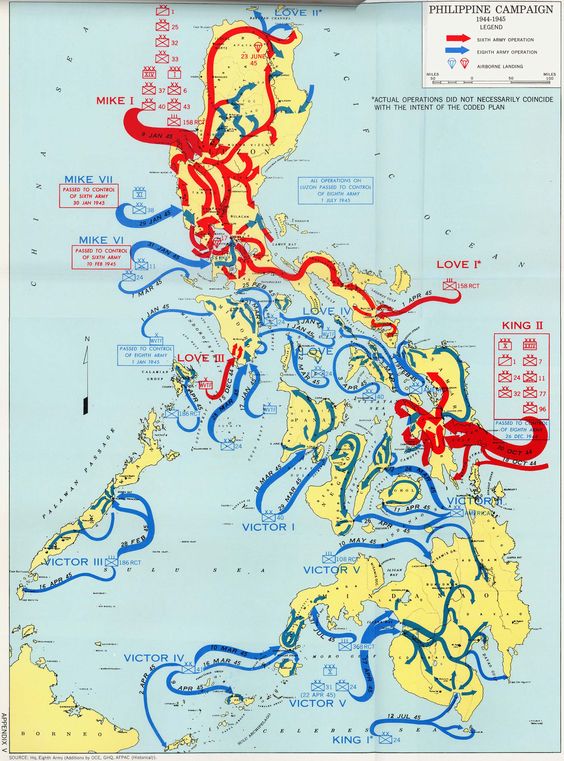
This map shows the entire Philippine campaign. The red arrows show the movements of the US 6th Army, which we already covered in Episode 50, 52 and 53. What the US 8th Army took in this episode is shown with the blue arrows.
Do you think you would like to become a podcaster on Blubrry? Click here for the details on joining. Enter my promo code, HSEASIA, to let them know I sent you, and you will get the first month's hosting for free!
Support this podcast!
Episode 53: The Liberation of the Philippines, Part 3
The American campaign in the Philippines continues into 1945 with this episode. Now that the Japanese fleet has been mostly destroyed, and the Americans have taken back Manila, they and the Filipino guerrillas go on to free the rest of the main island, Luzon.
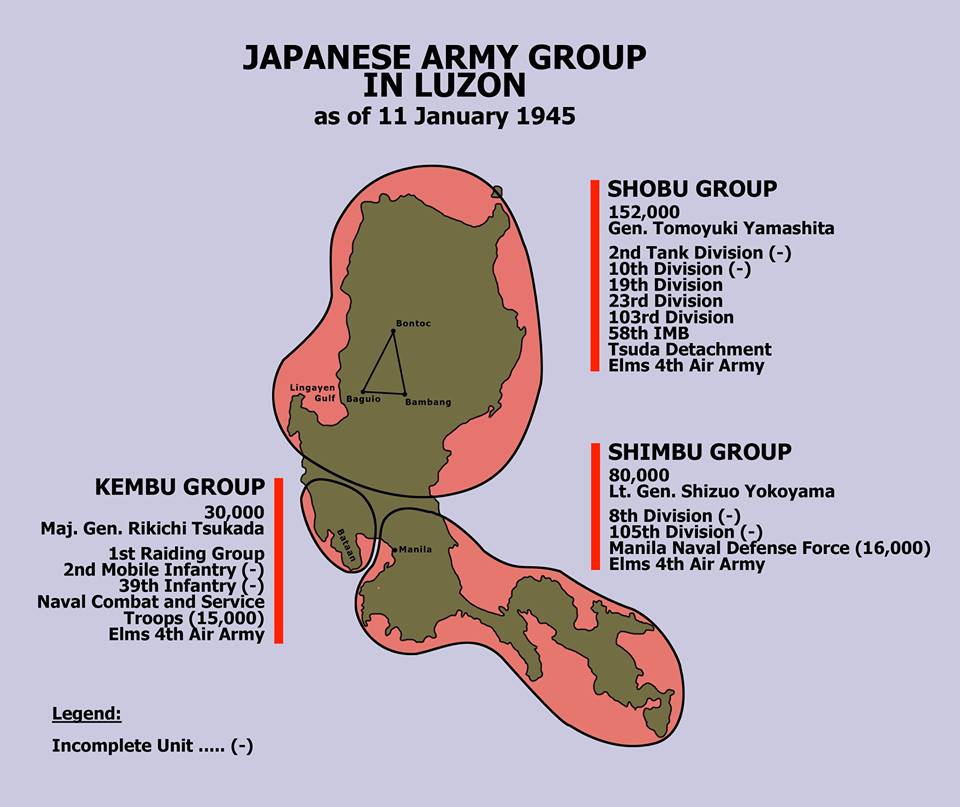
Here is a map of Luzon, showing how Japanese forces were distributed across the island when the Americans arrived. Source: a Facebook page dedicated to the 66th US Infantry Regiment.
Do you think you would like to become a podcaster on Blubrry? Click here for the details on joining. Enter my promo code, HSEASIA, to let them know I sent you, and you will get the first month's hosting for free!
Support this podcast!
Episode 52: The Liberation of the Philippines, Part 2
This episode continues, but doesn't quite finish, what we started in Episode 50, the American campaign to liberate the Philippines. General Douglas MacArthur's troops take the central islands of Leyte and Mindoro, then land on the main island, Luzon. The campaign culminates with the terrible battle for Manila in February 1945.
.png)
And I have reposted the map of the Philippines that was used with Episode 14, so listeners can see the locations for most of the places mentioned here.
Do you think you would like to become a podcaster on Blubrry? Click here for the details on joining. Enter my promo code, HSEASIA, to let them know I sent you, and you will get the first month's hosting for free!
Support this podcast!
Episode 51: Question and Answer Session 1
Today we take a break from the usual routine, and you will hear me answer the questions which you the listeners sent in over the past month or two. Listen and enjoy!
Do you think you would like to become a podcaster on Blubrry? Click here for the details on joining. Enter my promo code, HSEASIA, to let them know I sent you, and you will get the first month's hosting for free!
Support this podcast!
Episode 50: The Liberation of the Philippines, Part 1
This episode begins a series on the battles fought in the Philippines during 1944 and 1945, pitting the Americans and Filipinos against the Japanese. Here we will see General Douglas MacArthur land the US 6th Army on the island of Leyte, thereby keeping the promise he made two years earlier. Then the entire Japanese Navy will gather in the waters around Leyte to stop the landing, resulting in the biggest naval battle in all of World War II. Finally we will see the first use of Japan's desperate last tactic, kamikaze planes.
Here is the famous photo of MacArthur wading ashore at Leyte. Today on the spot where this happened, you can see a war memorial with seven bronze statues of MacArthur and his associates, re-enacting the landing (second picture). The man wearing the pith helmet is Sergio Osmena, the Philippine president at the time.
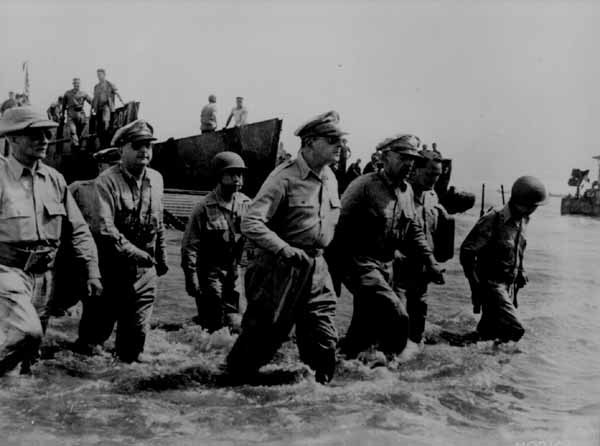
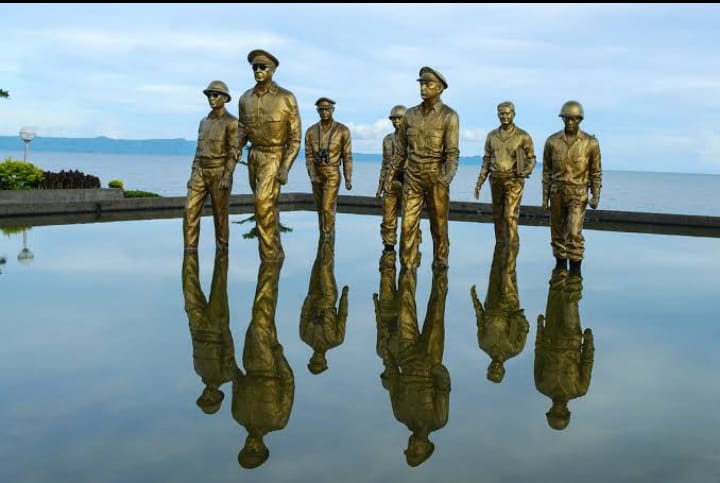
To understand the battle of Leyte Gulf you will need a map. This one comes from a 1959 Time Magazine article, which commemorated the 15th anniversary of the battle. You are looking at a thumbnail; click on it to see the map full size in a new tab.
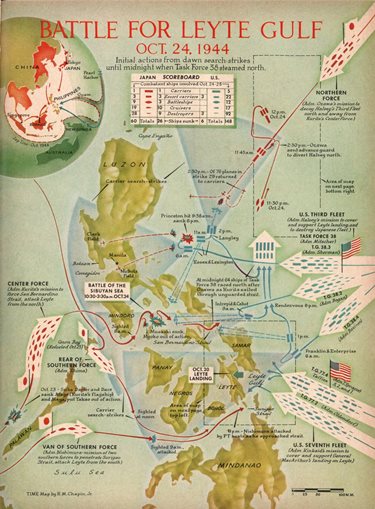
Do you think you would like to become a podcaster on Blubrry? Click here for the details on joining. Enter my promo code, HSEASIA, to let them know I sent you, and you will get the first month's hosting for free!
Support this podcast!
Episode 49: The Forgotten War in Burma, Part 2
Do you think you would like to become a podcaster on Blubrry? Click here for the details on joining. Enter my promo code, HSEASIA, to let them know I sent you, and you will get the first month's hosting for free!
Support this podcast!
Episode 48: The Forgotten War in Burma, Part 1
With this episode the podcast returns to Southeast Asia during World War II. This time we look at what happened in Burma, modern-day Myanmar, from the middle of 1942 until early 1944.
Orde Charles Wingate (1903-44) led British guerrilla units in Ethiopia and Burma during World War II. He is my favorite WW2 hero because he was a nonconformist who "thought outside the box" constantly. During the war he grew a nonregulation beard and wore a pith helmet, as you can see here. Source: WarHistoryOnline.com.
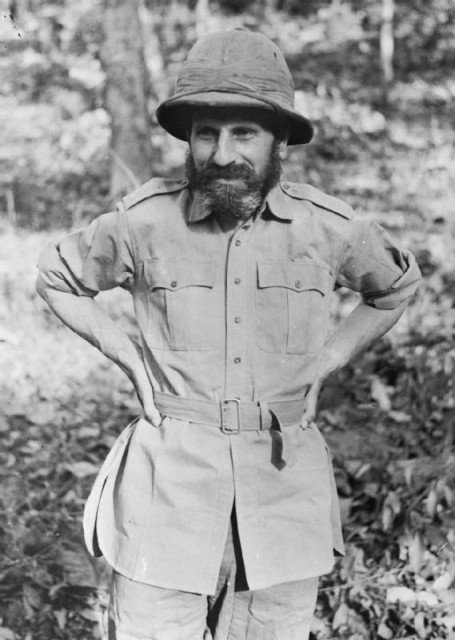
Do you think you would like to become a podcaster on Blubrry? Click here for the details on joining. Enter my promo code, HSEASIA, to let them know I sent you, and you will get the first month's hosting for free!
Support this podcast!
Episode 47: The New Guinea Campaign, Part 3
With today's episode, the podcast finishes covering World War II in New Guinea. Although the war turned in the Allies' favor in 1942, the struggle here would go on until the war ended everywhere else. The Allies find out that in every territory occupied by Japan, it is at least twice as hard to drive the Japanese out, as it was for them to invade the territory in the first place. Also, today is the second anniversary of the podcast's launching. Happy birthday, podcast!
This map of New Guinea shows where General MacArthur landed troops in 1944, to liberate the island and establish an advance base before moving on to the Philippines. Source: History.army.mil.
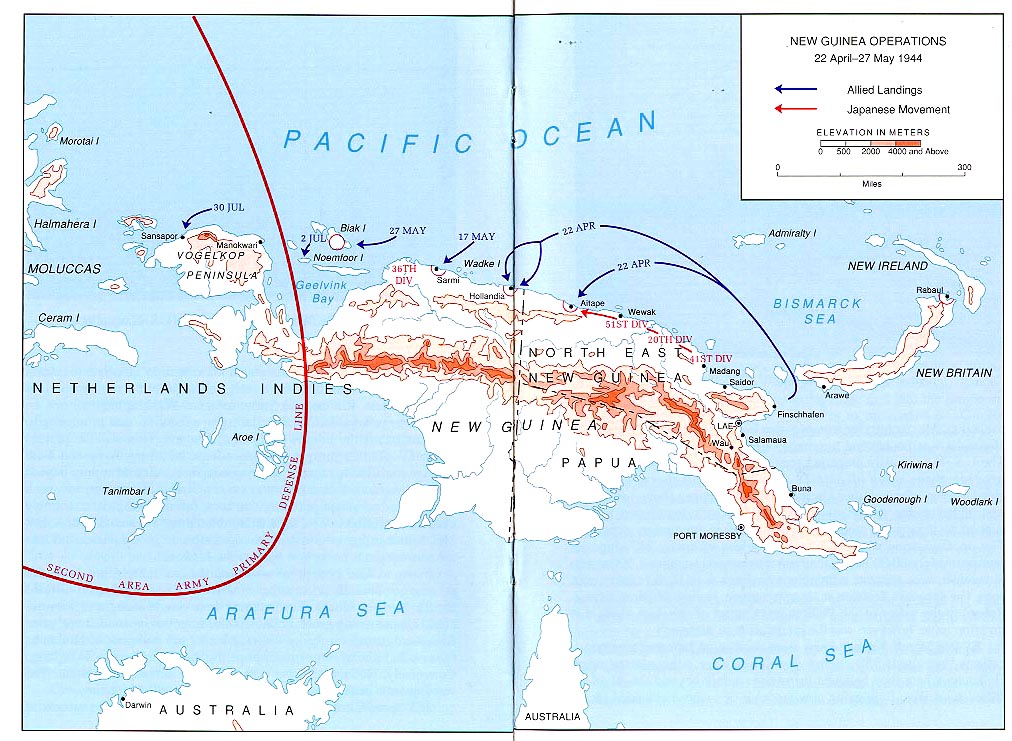
Since World War II, The Phantom, one of the oldest comic book super heroes, has been a popular art subject in Papua new Guinea. Here he has been painted onto a wooden shield. The last part of this episode explains why Papuans are crazy for him. Source: Wikimedia Commons.
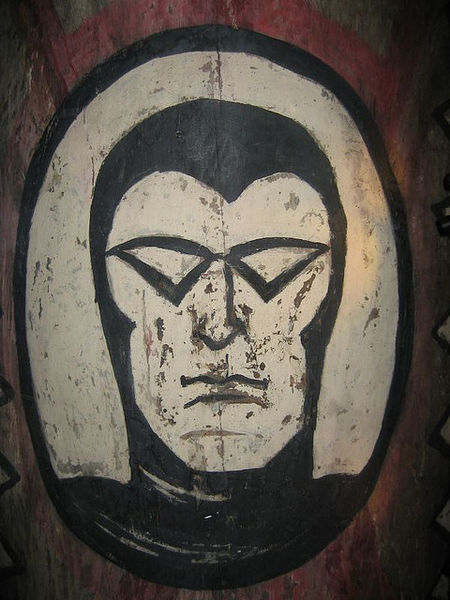
And for your websurfing pleasure, Here are some photos from the New Guinea campaign:
https://www.worldwarphotos.info/gallery/usa/pacific/new-guinea
Do you think you would like to become a podcaster on Blubrry? Click here for the details on joining. Enter my promo code, HSEASIA, to let them know I sent you, and you will get the first month's hosting for free!
Support this podcast!
Episode 46: The New Guinea Campaign, Part 2
The podcast is back, after a month-long break! Here we continue the coverage we started in the previous episode, about World War II in New Guinea. This time we will see the crucial turning point in the conflict between the Japanese, Australians and Americans.
This map of New Guinea gives you an overview of the island during World War II; most of the cities and towns I mention in Episodes 45 and 46 are shown here. Before the war the western half of the island was part of Dutch-ruled Indonesia, while the two territories in the east, N.E. New Guinea and Papua, were ruled by Australia. The mountains running through the middle, the Owen Stanley Range, also roughly mark the front line in the second half of 1942; the Japanese captured most of what was north of the mountains, while the Allies held on to everything south of the mountains, as well as Milne Bay on the island's eastern tip. Source: www.historyofwar.org.
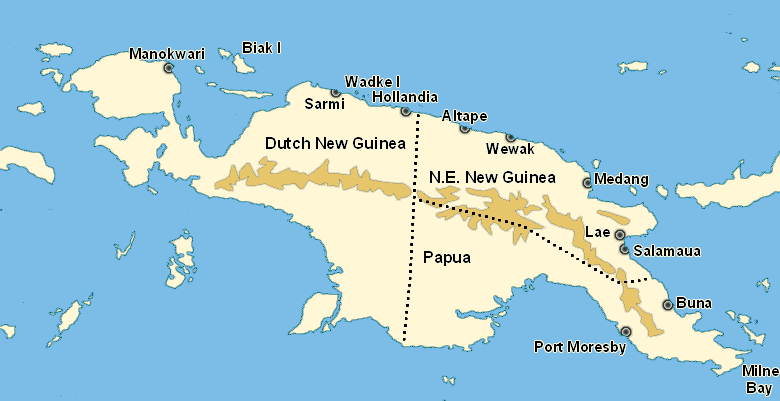
Here is the first of two maps that show in detail the course of the battles covered in the next podcast episode. This map shows southeastern New Guinea, the "tail" of the island. The rectangles enclose the areas shown on the second map. Also visible is Milne Bay on New Guinea's eastern tip.
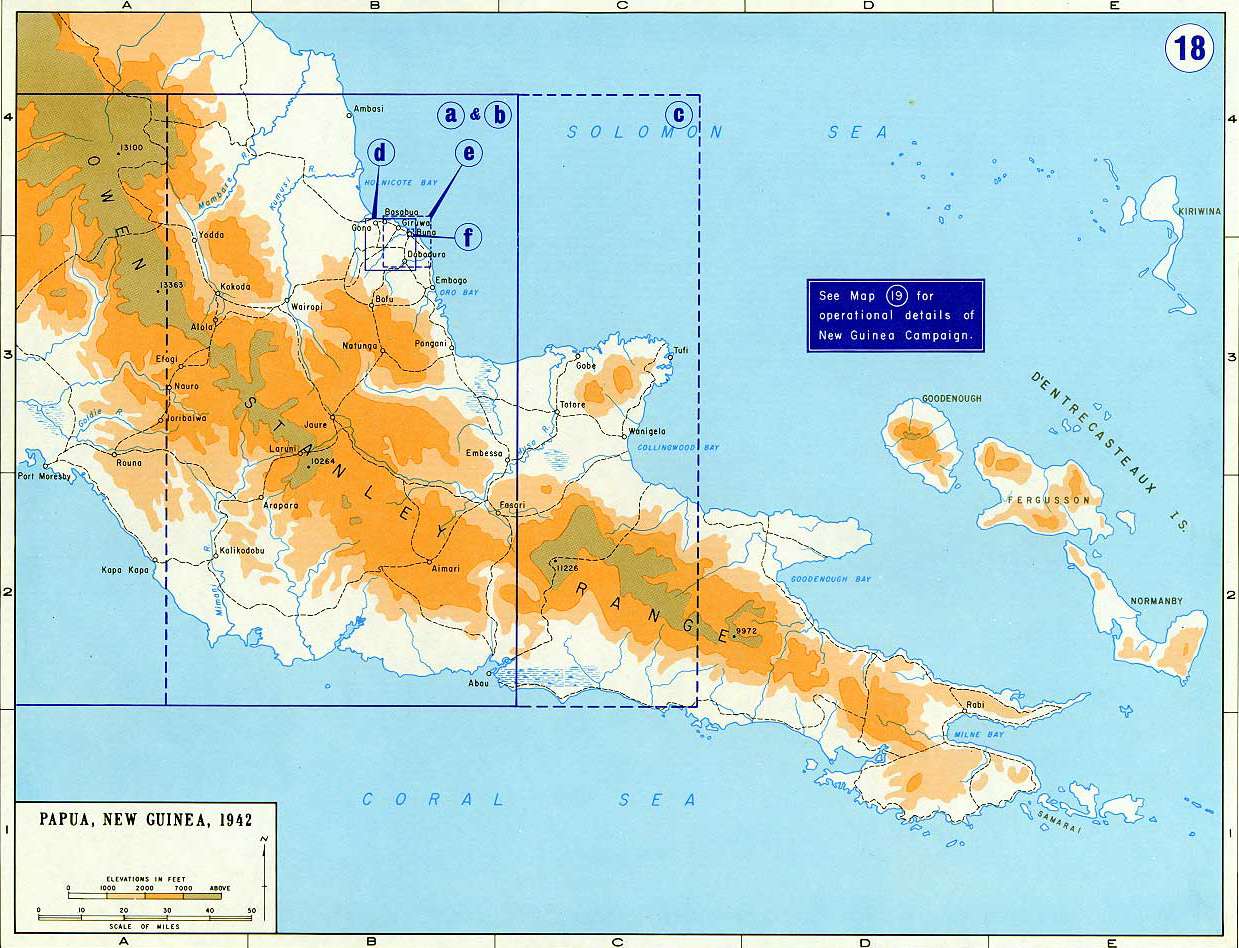
This map (or "maps" if you prefer) shows six closeups of the Kokoda Track and the Buna beachhead. I found this map and the previous one on two websites: www.EmersonKent.com and www.WestPoint.edu. Unfortunately I don't know which of them had the maps first, so I am listing both as my sources here.
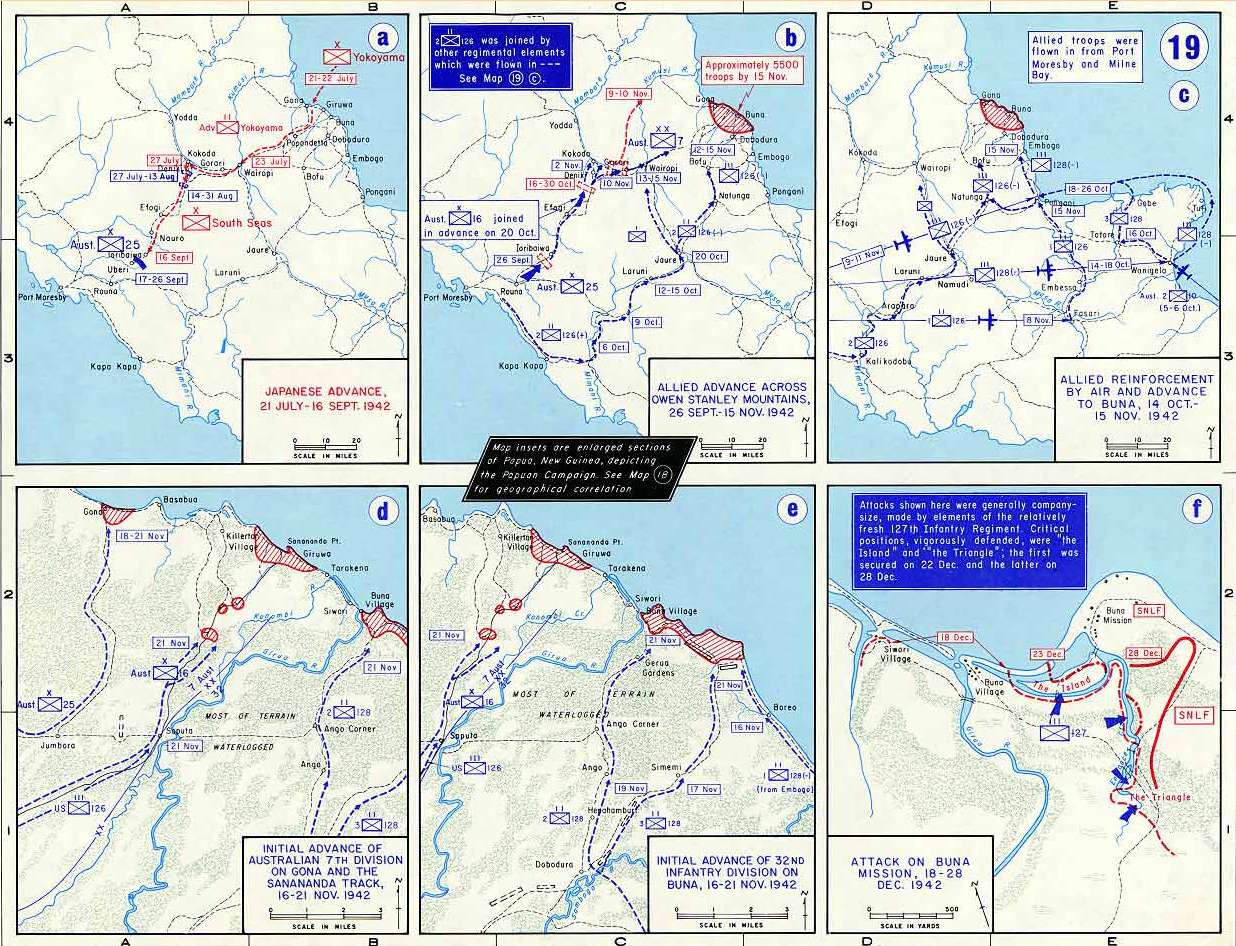
Do you think you would like to become a podcaster on Blubrry? Click here for the details on joining. Enter my promo code, HSEASIA, to let them know I sent you, and you will get the first month's hosting for free!
Support this podcast!
I Am Going Away For A While
The next episode is going to be late. Originally I was planning to record and upload it by June 1, but now it looks like I will have to aim for a release date in the middle of June. Listen in to find out more.
Episode 45: The New Guinea Campaign, Part 1
Do you think you would like to become a podcaster on Blubrry? Click here for the details on joining. Enter my promo code, HSEASIA, to let them know I sent you, and you will get the first month's hosting for free!
Support this podcast!
Introducing American Innovations
Today a new podcast has been launched that I think you're going to love. It is called "American Innovations," and it combines science and history with a dramatic presentation. Check it out on iTunes, listen and enjoy! I know I'm going to.
American Innovations by Wondery
Episode 44: Life Under the Japanese
Today marks a new month, and you know what that means -- it's time for a new episode! This time we have an overview of what life was like for those in Southeast Asia, during the years when Japan ruled the region (hint: most of it is bad.)
A Ten Peso bill, printed by the Japanese for use in the Philippines. Inflation soon made them nearly worthless, and because the Filipinos had been exposed to Hollywood movies, they scornfully called this "Mickey Mouse money."
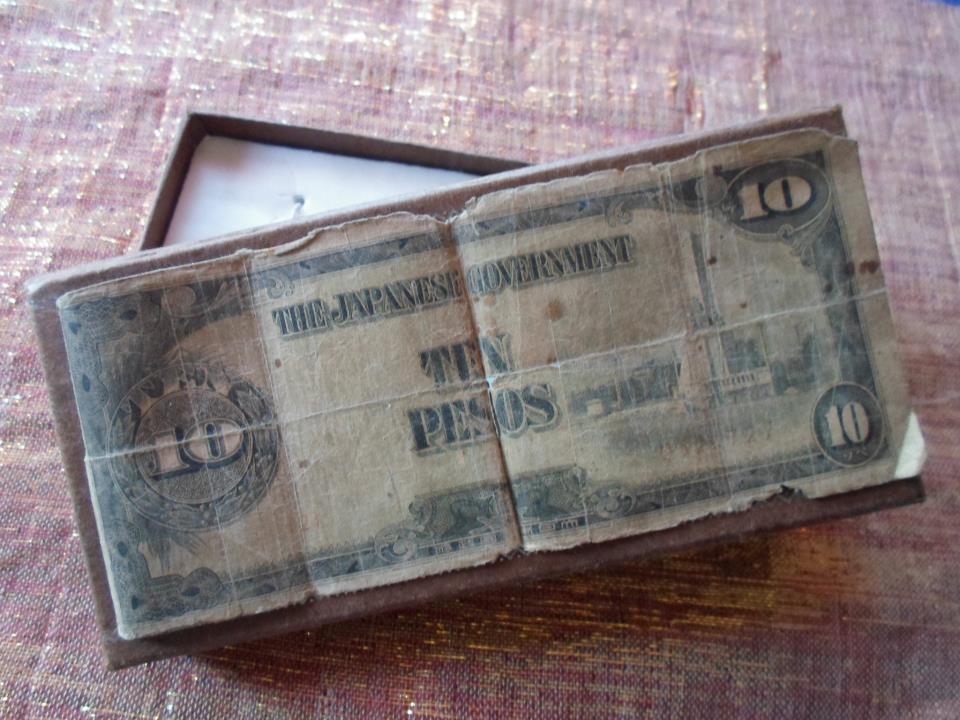
The Axis leaders in Asia only met once, at the Greater East Asia Conference, held in Tokyo on November 5-6, 1943. No big announcements or decisions were made, the conference just presented an image of solidarity among the participants. Shown here from left to right are Ba Maw (Burma), Zhang Jinghui (Manchukuo prime minister), Wang Jingwei (China Proper), Hideki Tojo (Japan), Wan Waithayakon (Thailand prime minister), José P. Laurel (Philippines), Subhas Chandra Bose (India). Not attending: Prince Teh (Demchugdongrub) of Inner Mongolia.
Between 1,200 and 1,300 German and Austrian Jews escaped the Holocaust in Europe by going to the Philippines. Here is a crowd of them at the house of Alex Frieder, the most prominent Jew in Manila. This photo was taken on April 30, 1940.
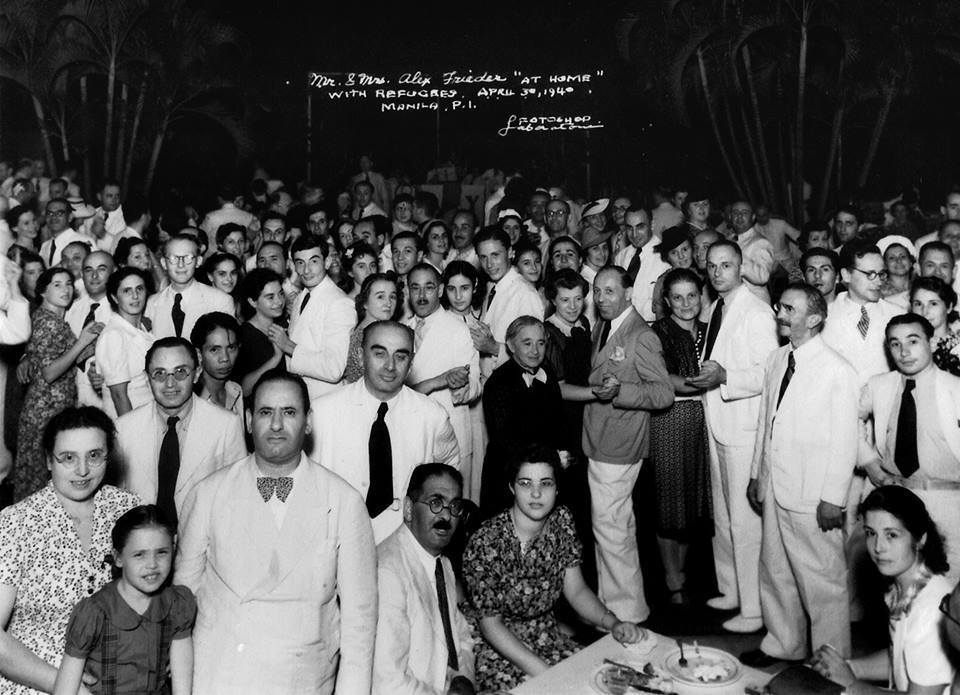
Do you think you would like to become a podcaster on Blubrry? Click here for the details on joining. Enter my promo code, HSEASIA, to let them know I sent you, and you will get the first month's hosting for free!
Support this podcast!
Episode 43: The Indian Ocean
Today we have a diversion from the narrative the podcast has been following lately. When Japan conquered Southeast Asia in early 1942, it gained access to the Indian Ocean, and the Japanese ventured into that ocean afterwards. This episode will look at what followed: the invasion of the Andaman & Nicobar Islands, the bombing of Ceylon (modern Sri Lanka), and a battle between the British, French and Japanese for Madagascar. Although this area is not in Southeast Asia per se, I believe you will find the stories interesting, because they are really obscure to those people who don't live around the Indian Ocean. That includes the host; I did not hear any of this in school! Now listen and enjoy.
During World War II, the Japanese had an Indian nationalist on their side, Subhas Chandra Bose, and after they conquered the Andaman and Nicobar Islands, they put Bose in charge of them. This picture was taken during the first and only time he visited the islands, at the end of 1943. Bose saw the islands as the first province of a future independent Indian state, but in reality he was nothing more than a Japanese puppet.
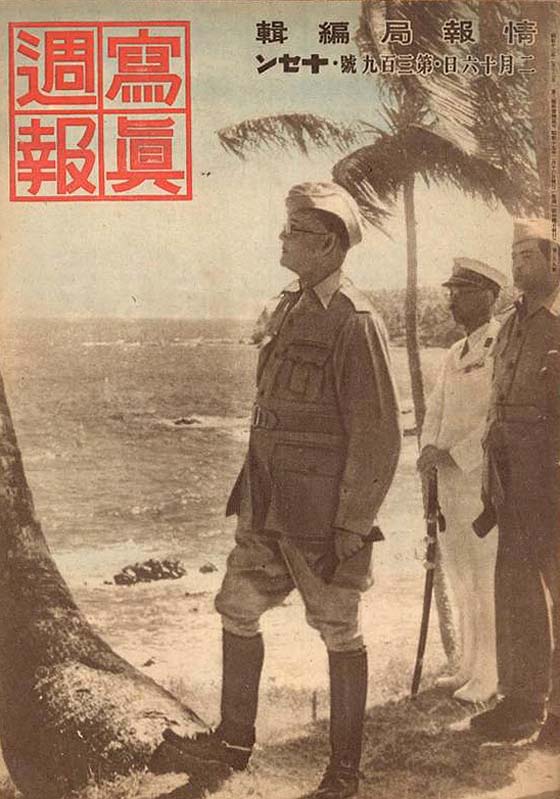
This map shows three of the places in the Indian Ocean that will be discussed in Episode 43. The place I called Ceylon in the narrative has been called Sri Lanka since 1972. The Maldives, Andamans and Nicobars are flyspeck islands; you will have to look closely to see the dots marking them. Madagascar is off the left edge of the map, near Mozambique and South Africa.
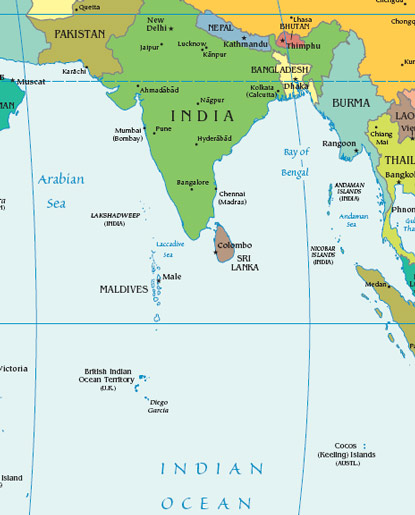
Here is the only map I could find for Madagascar in World War II. Unfortunately I just broke one of my own rules. In the recording I used the present-day name of Antananarivo for the capital, while the map uses the old French name of Tananarive. I should have known better!
Source: Simon Goodenough, "War Maps (World War II from September 1939 to August 1945, Air Sea and Land, Battle by Battle: World War II from September 1939 to August 1945, Air, Sea, and Land, Battle by Battle)", ISBN-10: 0312051786, St. Martin's Press, 1982.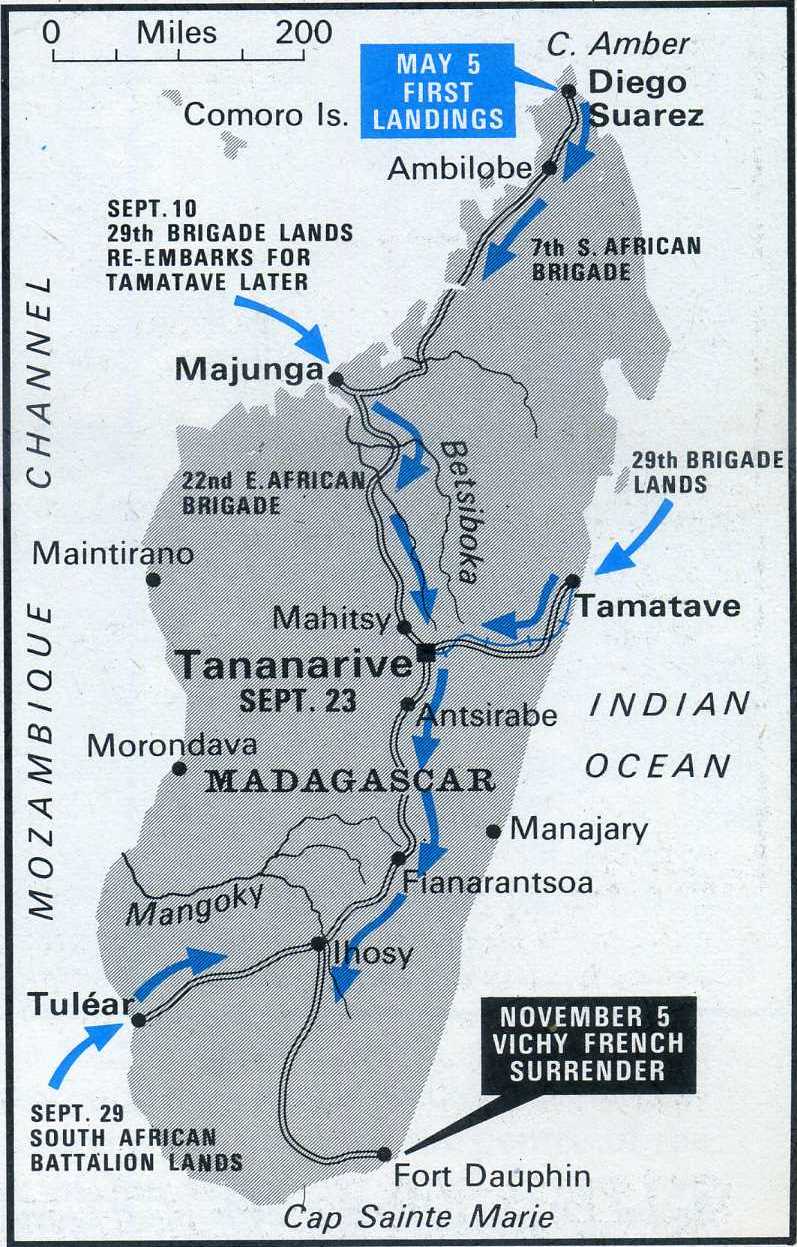
Do you think you would like to become a podcaster on Blubrry? Click here for the details on joining. Enter my promo code, HSEASIA, to let them know I sent you, and you will get the first month's hosting for free!
Support this podcast!
Episode 42: The Retreat Through Burma
I was hoping that I wouldn't need a map for the next episode, but so many place names are mentioned that it now looks necessary. This one shows the Japanese advance (red) in Burma/Myanmar in April 1942, and the escape routes used by the Allies to evacuate the British colony (blue). Source: Ibiblio.org.
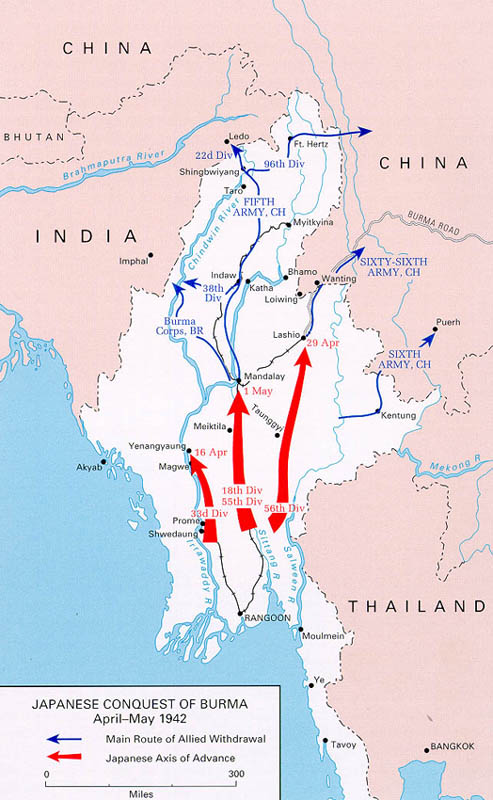
Here General Joseph "Vinegar Joe" Stilwell leads his staff and a group of soldiers, as they retreat from Burma to India, in May 1942. The good news is that there were 114 people in the group, and Stilwell did not lose a single one. Source: History.army.mil.
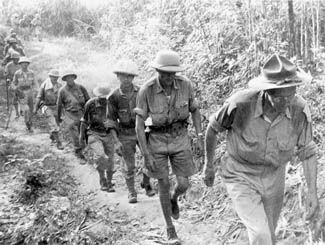
Do you think you would like to become a podcaster on Blubrry? Click here for the details on joining. Enter my promo code, HSEASIA, to let them know I sent you, and you will get the first month's hosting for free!
Support this podcast!
Episode 41: The Battle for the Philippines, Part 2
Now it is time to finish what we started in Episode 38, and cover the conclusion of the Japanese invasion of the Philippines. Although the Japanese win again, it takes five months for them to conquer the islands, a longer time than any of their other campaigns so far, because both the Americans and Filipinos were united in resisting them.
Both of the maps below are thumbnails. Click on either one to see the full-sized map in a separate tab or window.
First, for your benefit, I have reposted the map pf Bataan and Corregidor from Episode 38. Source: the Perry-Castañeda Library Map Collection, on the University of Texas website.
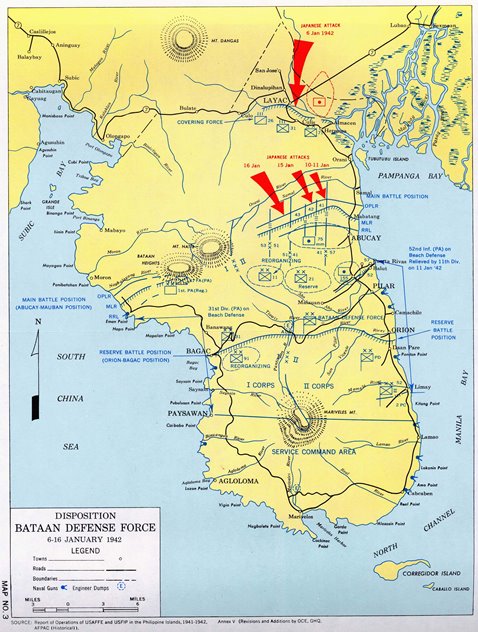
And here is the best map I have found so far about the Japanese invasion of the Philippines. It is the only one that gives equal attention to activities in the central and southern islands, in addition to the campaign on Luzon. Source: Indohistorian.tumblr.com
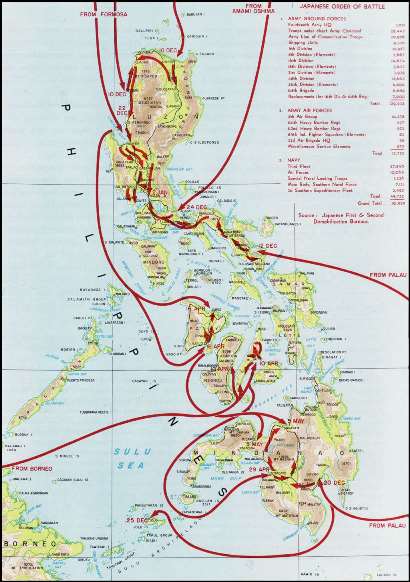
Do you think you would like to become a podcaster on Blubrry? Click here for the details on joining. Enter my promo code, HSEASIA, to let them know I sent you, and you will get the first month's hosting for free!
Support this podcast!
Episode 40: The History Fangirl Interview
This episode is a break from the narrative usually presented. Recently Charles Kimball was interviewed for another podcast, History Fangirl, to give the historical background behind Thailand and Bangkok. A copy of that interview has been reposted here. And below is a link to the podcast of Stephanie Craig, the History Fangirl; check it out to see what other places she has visited.
Bangkok and the Kingdom of Siam
Do you think you would like to become a podcaster on Blubrry? Click here for the details on joining. Enter my promo code, HSEASIA, to let them know I sent you, and you will get the first month's hosting for free!
Support this podcast!
Episode 39: Japan Goes South
Here is the companion map, showing the paths taken by the Japanese in the Dutch East Indies. As you can see, they ignored no island large enough to matter. At the end of February 1942, they also landed on both ends of Java. By the end of March, the only unconquered areas were eastern Timor (where Australian guerrillas resisted until February 1943) and western New Guinea.
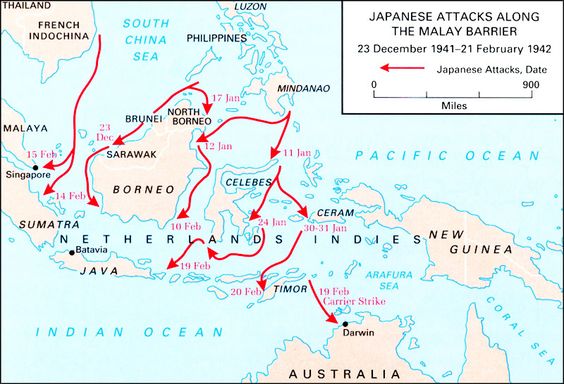
Do you think you would like to become a podcaster on Blubrry? Click here for the details on joining. Enter my promo code, HSEASIA, to let them know I sent you, and you will get the first month's hosting for free!
Support this podcast!
Episode 38: The Battle for the Philippines, Part 1
Episode 38 continues on the topic the podcast has been covering since the year began -- World War II in Southeast Asia. This time we will see the Japanese invasion of the Philippines begin, but it won't finish in this episode; resistance to the Japanese is far tougher here than it was in Malaya and Singapore. And this episode will also give the biography of the American commander, Douglas MacArthur, up to 1941, because he will be a key figure in the war from this point on.
Here is the first of two maps that will help you understand the narrative. When the Japanese invaded the Philippines, both they and the Americans concentrated most of their attention on Luzon, the largest and most important island. On this map you can see where the Japanese landed, and their movements until General MacArthur withdrew the American and Filipino troops to Bataan and Corregidor. This is a public domain map that apparently was created for the website History.army.mil, but I found it on several websites, including Wikipedia and Historylink101.com.
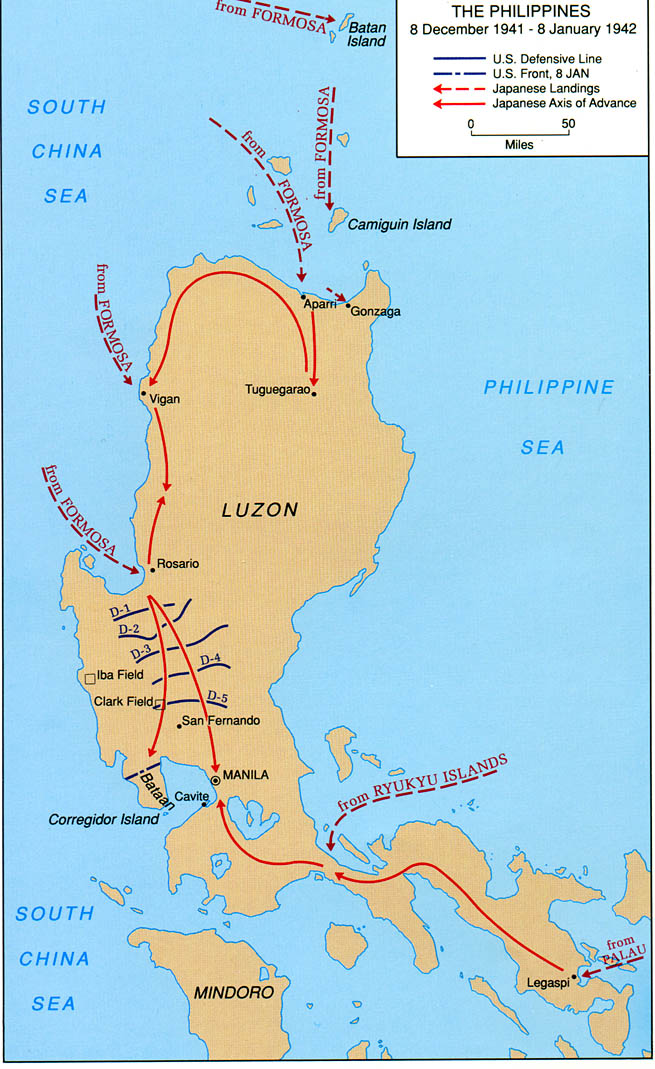
And here are Bataan and Corregidor, seen close up. Like the previous map, it shows the places I will talk about in this episode. The source is the Perry-Castañeda Library Map Collection, on the University of Texas website. This map is a thumbnail; click on it to see the full sized map.

Do you think you would like to become a podcaster on Blubrry? Click here for the details on joining. Enter my promo code, HSEASIA, to let them know I sent you, and you will get the first month's hosting for free!
Support this podcast!
Episode 37: Japan Strikes, The Fall of Malaya and Singapore
In the last episode you heard about Japan invading China, occupying French Indochina, and bombing Pearl Harbor. Now this episode covers the 1941 Japanese invasion of Thailand, Malaya, and Singapore. Are you ready?
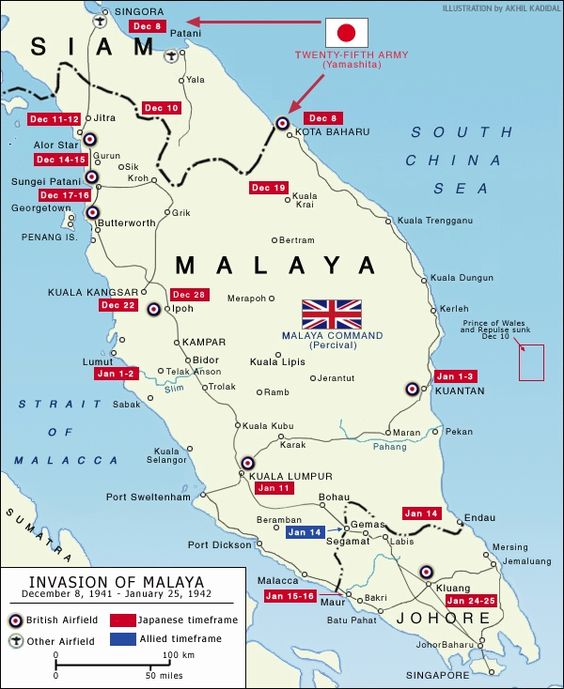
Here is the companion map, showing the campaign in Malaya, December 1941-January 1942. The red dates are the dates when the Japanese conquered specific locations, while the blue date indicates when the British formed a defensive line to protect Johore, the southernmost of Malaya's nine sultanates.
Do you think you would like to become a podcaster on Blubrry? Click here for the details on joining. Enter my promo code, HSEASIA, to let them know I sent you, and you will get the first month's hosting for free!
Support this podcast!
Episode 36: Prelude to the Pacific War
Happy New Year, and to begin 2018, the podcast will begin covering the course of World War II in Southeast Asia. We will start by looking at the events in the early twentieth century that motivated Japan to conquer most of East Asia and the western Pacific, and we will finish with the event that brought the United States into the war, the attack on Pearl Harbor.
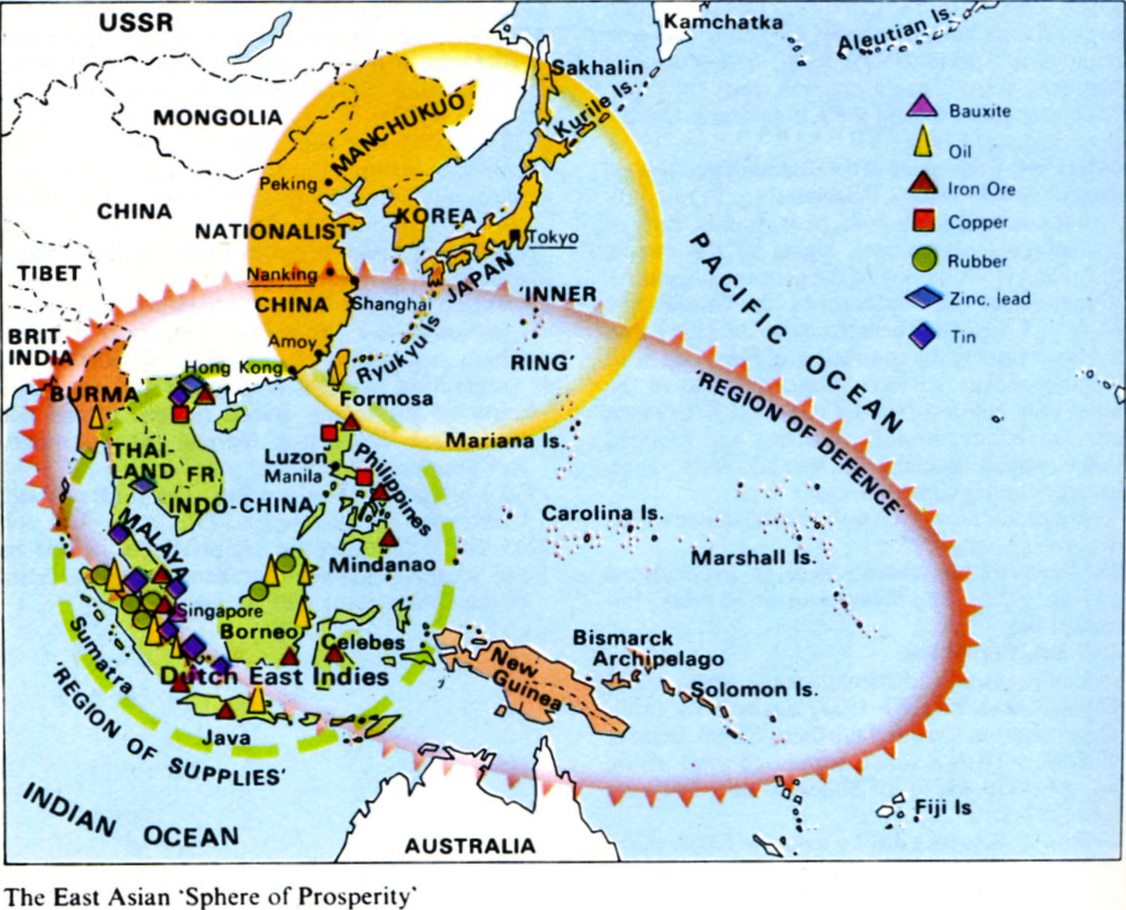
This map is a simple, graphic representation of Japan's strategy during World War II. Most of the area within the gold circle was under Japanese rule by the end of the 1930s. To complete the conquest of that area, the Japanese became interested in the resource-rich green circle (most of Southeast Asia), and they would add that between 1940 and 1942. Note the symbols indicating the minerals that Japan wanted and needed. After Pearl Harbor they also went for the lands within the red oval, plus Wake Island and part of the Aleutian Islands on the right, to form a defensive perimeter around the other areas.
Do you think you would like to become a podcaster on Blubrry? Click here for the details on joining. Enter my promo code, HSEASIA, to let them know I sent you, and you will get the first month's hosting for free!
Support this podcast!
Episode 35: French Indochina, Part 4
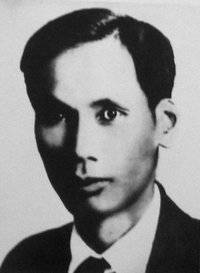
Here is how Ho Chi Minh looked when he lived in Paris, between 1917 and 1923. Not only was he young and clean shaven, he lived under several false names, his favorite being Nguyen Ai Quoc.
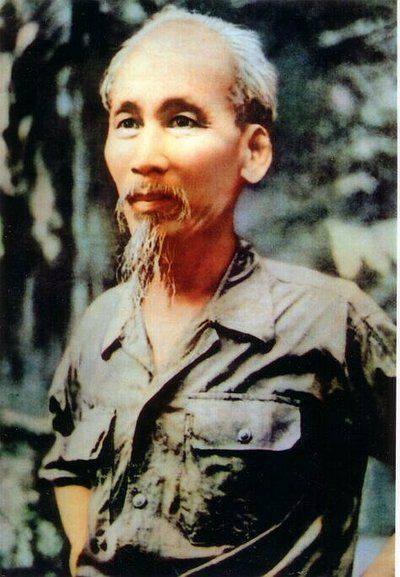
And here is the Ho Chi Minh you're familiar with, if you know anything about the Vietnam War. This picture was taken sometime in the 1950s.
Do you think you would like to become a podcaster on Blubrry? Click here for the details on joining. Enter my promo code, HSEASIA, to let them know I sent you, and you will get the first month's hosting for free!
Support this podcast!
Episode 34: French Indochina, Part 3
Do you think you would like to become a podcaster on Blubrry? Click here for the details on joining. Enter my promo code, HSEASIA, to let them know I sent you, and you will get the first month's hosting for free!
Support this podcast!
Episode 33: Nationalism in the Dutch East Indies
This episode continues our narrative on Southeast Asia in the early twentieth century, by looking at Indonesia, then called the Dutch East Indies, from 1901 to 1941 (A.D.). First we will learn how oil was discovered in the islands, and how it replaced spices as Indonesia's most important product. Then we will see how the Dutch administered the islands during that time. Finally we will follow the development of Indonesian nationalism, and meet Sukarno, the first leader of modern Indonesia.
Do you think you would like to become a podcaster on Blubrry? Click here for the details on joining. Enter my promo code, HSEASIA, to let them know I sent you, and you will get the first month's hosting for free!
Support this podcast!
Episode 32: Nationalism in British Burma
For our 32nd episode (33rd if you count the introduction), we will return to the Southeast Asian mainland, and cover the history of Burma, modern-day Myanmar, in the early twentieth century. In particular we will concentrate our attention on the nationalist movements that sprang up, to oppose British rule. Three of the nationalists we will meet here, Aung San, U Nu and Ne Win, will become important in future episodes, so remember their names!
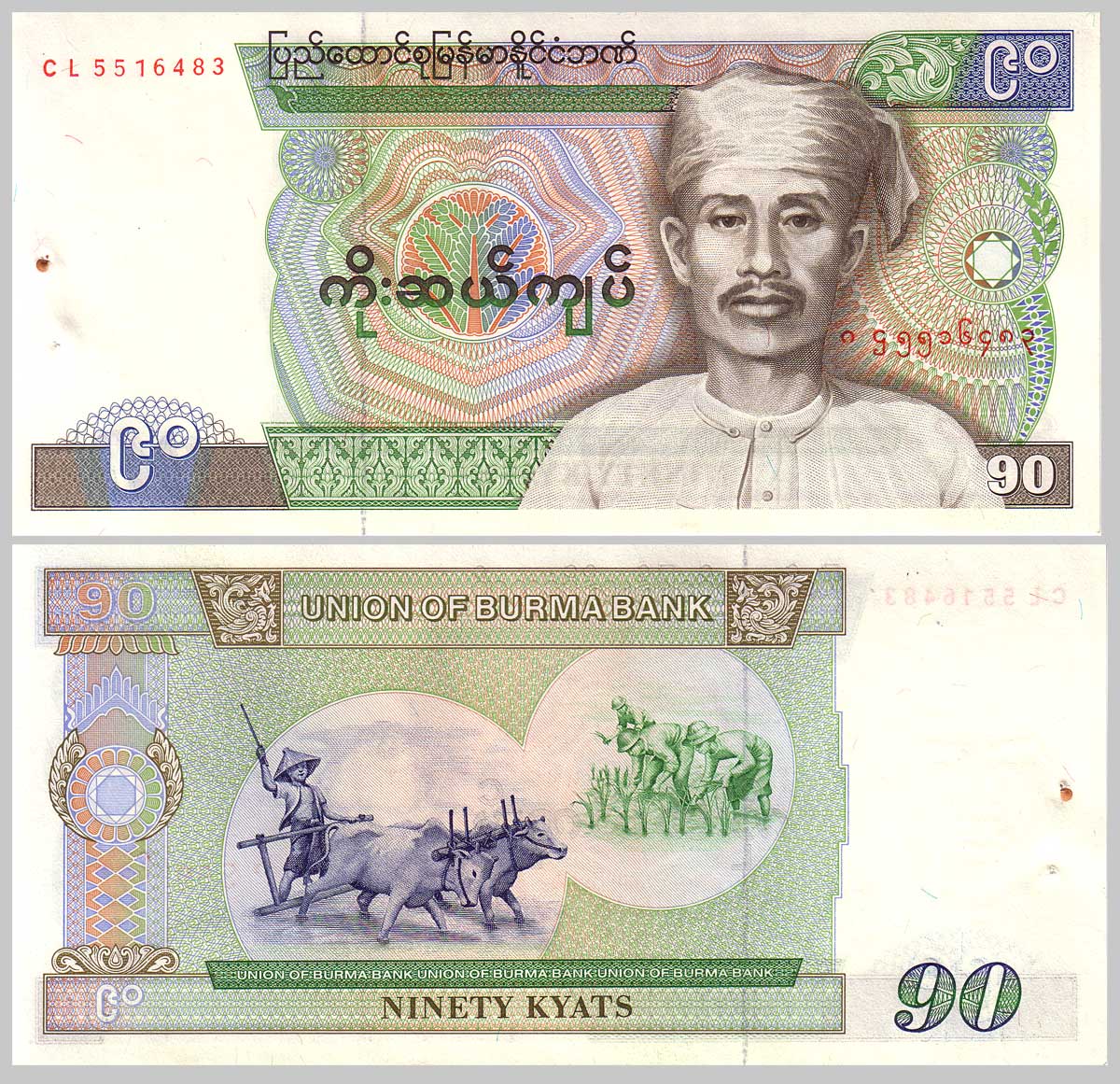
This sample of Burmese money is a 90 Kyat bill, issued in 1987, and on the front it shows Saya San, who led an unsuccessful revolt against British rule in 1931. 90 Kyat bills were a legal denomination because Ne Win believed that 9 and multiples of 9 were lucky numbers, but that’s a wild story I am saving for another time.
Do you think you would like to become a podcaster on Blubrry? Click here for the details on joining. Enter my promo code, HSEASIA, to let them know I sent you, and you will get the first month's hosting for free!
Support this podcast!
Episode 31: The Philippines, the Hollywood Years
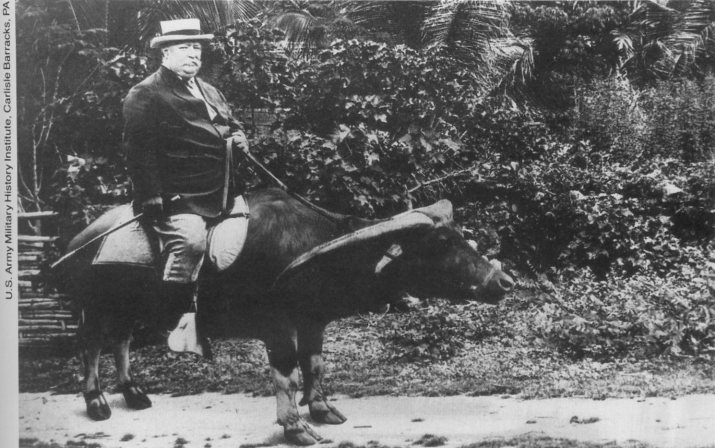
The first civilian governor that the United States put over the Philippines was a future US president, William Howard Taft. He served from 1900 to 1904, and because he weighed 325 lbs., Americans remember him as their biggest president. Here he is in 1901 riding a water buffalo, or as the Filipinos call it, a carabao. Can you tell which is bigger?
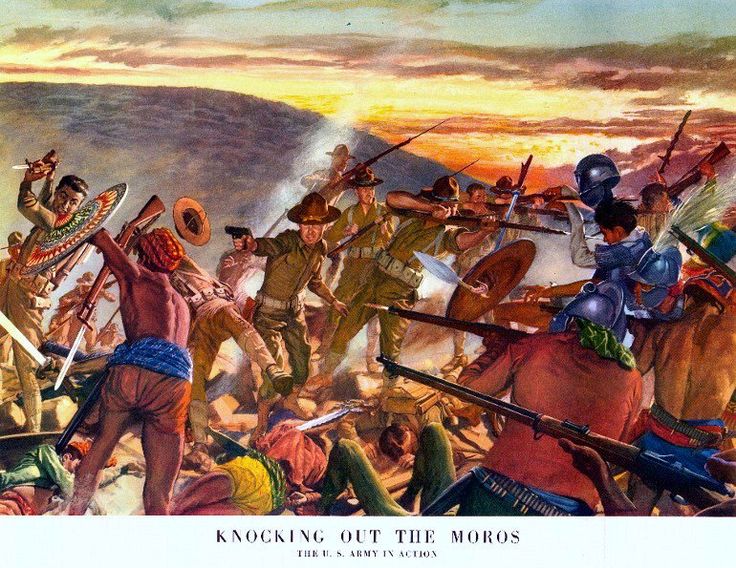
And here a scene from the final battle of the Moro War, the battle of Bud Bagsak. This was painted in 1963, fifty years after the battle took place, so I have a feeling some details were left out, like the fact that the Moros had their families at the site of the battle.
Do you think you would like to become a podcaster on Blubrry? Click here for the details on joining. Enter my promo code, HSEASIA, to let them know I sent you, and you will get the first month's hosting for free!
Support this podcast!
Episode 30: The American War in the Philippines
This is the third episode in the mini-series we are currently doing about the Philippines. Here we cover the three-year war the Americans fought to keep the islands after they arrived in 1898. This also completes our narrative on Southeast Asia in the nineteenth century.
Do you think you would like to become a podcaster on Blubrry? Click here for the details on joining. Enter my promo code, HSEASIA, to let them know I sent you, and you will get the first month's hosting for free!
Support this podcast!
Episode 29: America Comes to the Philippines
Do you think you would like to become a podcaster on Blubrry? Click here for the details on joining. Enter my promo code, HSEASIA, to let them know I sent you, and you will get the first month's hosting for free!
Support this podcast!
Episode 28: Philippine Nationalism
Do you think you would like to become a podcaster on Blubrry? Click here for the details on joining. Enter my promo code, HSEASIA, to let them know I sent you, and you will get the first month's hosting for free!
Support this podcast!
Episode 27: A New Siam
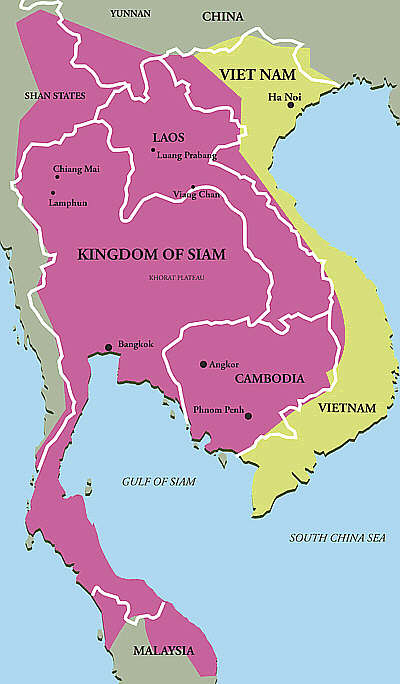
Here is a map of Siam in the early 1800s, when the kingdom was at its greatest size. These borders lasted until 1863, when Britain and France started taking parts of the kingdom for themselves. The core territory they left behind became present-day Thailand in 1939.
Do you think you would like to become a podcaster on Blubrry? Click here for the details on joining. Enter my promo code, HSEASIA, to let them know I sent you, and you will get the first month's hosting for free!
Support this podcast!
Episode 26: French Indochina, Part 2
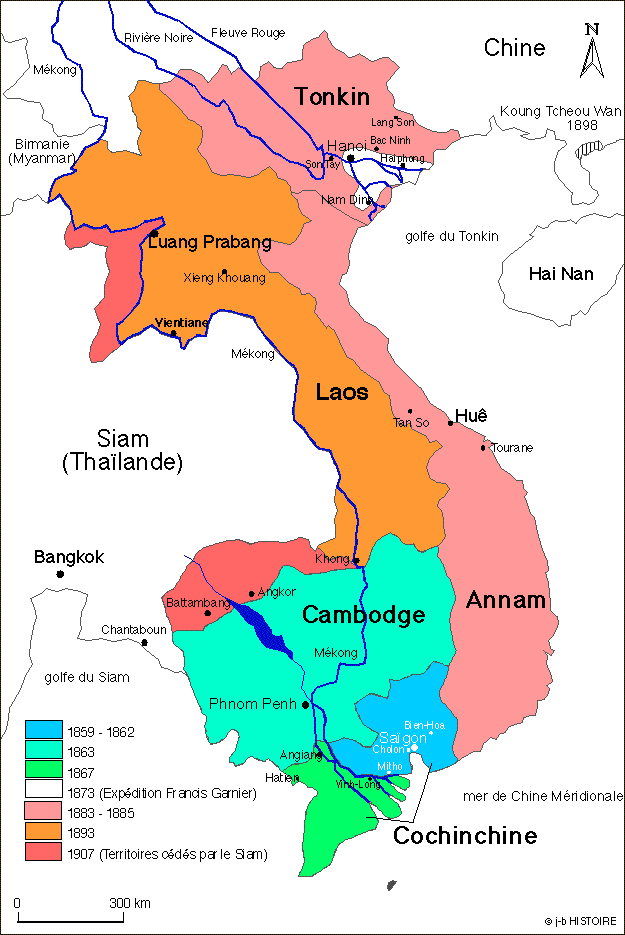
This map shows the French conquest, step by step. Although it is a French language map, if you can read English you should be able to figure out what the text is saying in most places. The white area around Hanoi was temporaily captured by Francis Garnier's 1873 expedition, and conquered more permanently in 1883.
Do you think you would like to become a podcaster on Blubrry? Click here for the details on joining. Enter my promo code, HSEASIA, to let them know I sent you, and you will get the first month's hosting for free!
Support this podcast!
Episode 25: French Indochina, Part 1
Do you think you would like to become a podcaster on Blubrry? Click here for the details on joining. Enter my promo code, HSEASIA, to let them know I sent you, and you will get the first month's hosting for free!
Support this podcast!
Episode 24: On the Road to Mandalay
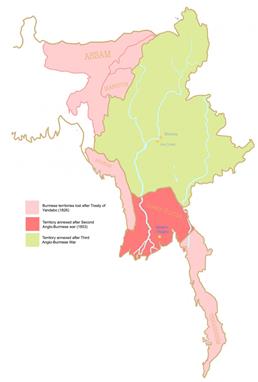
I have several pictures to share today. The first is a map showing Britain's gains in the Anglo-Burmese Wars. This is a thumbnail; click on the picture to see it full size (it will open in a separate window). The British proclaimed their rule over the pink territories in 1826, the red area in 1853, and the green area in 1886.
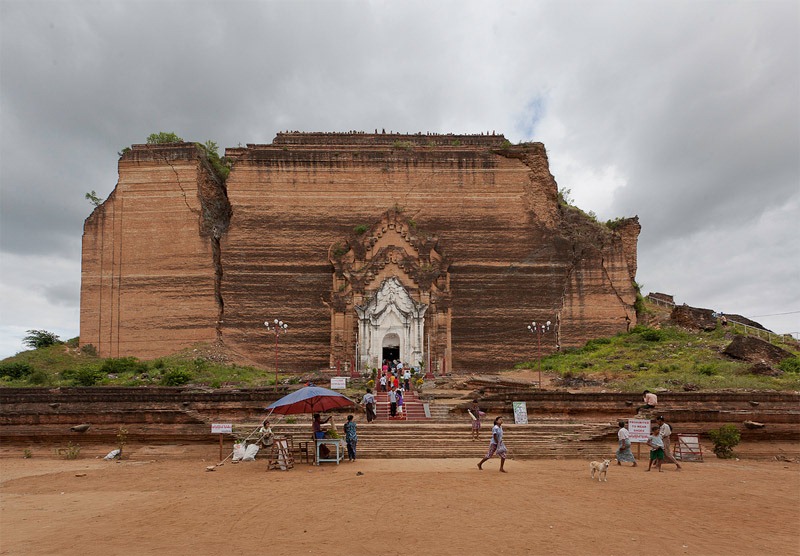
Here is what I call the Burmese answer to the Tower of Babel -- the Mingun Pahtodawgyi Pagoda. If it had been completed, it would have been the world's largest pagoda, standing 490 feet high. The unfinished ruins are 172 feet high today.
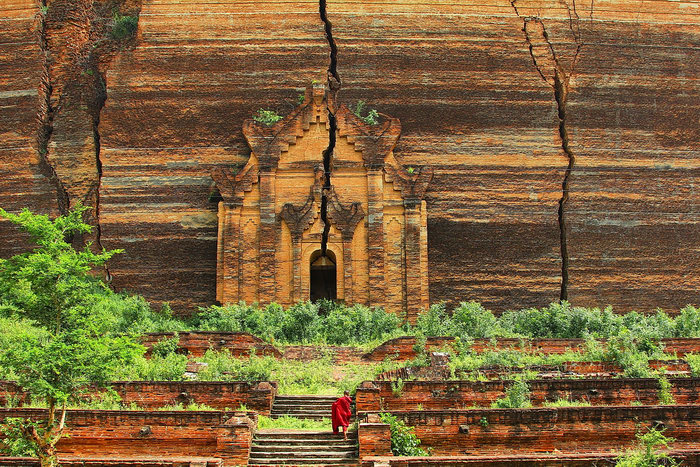
And here is the other side of Mingun, showing the main archway split by the 1838 earthquake.
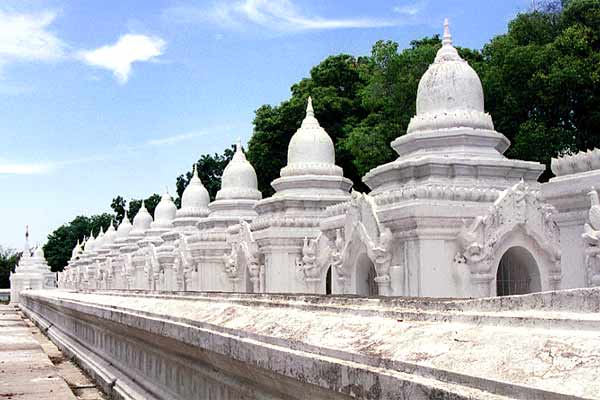
Some of the shrines around the Kutho Daw Pagoda in Mandalay. Each shrine is built over a stone slab, carved with Buddhist scriptures.
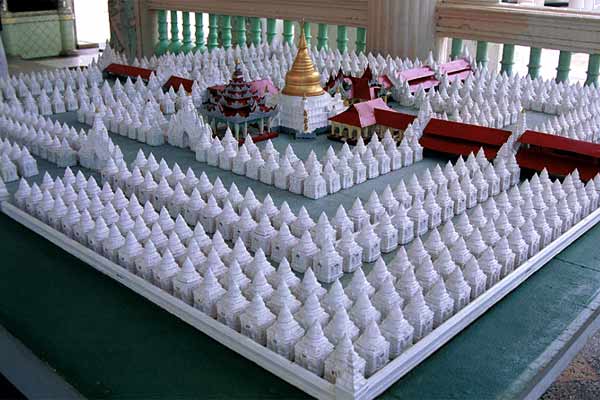
A model of the whole Kutho Daw complex, the world's heaviest book.
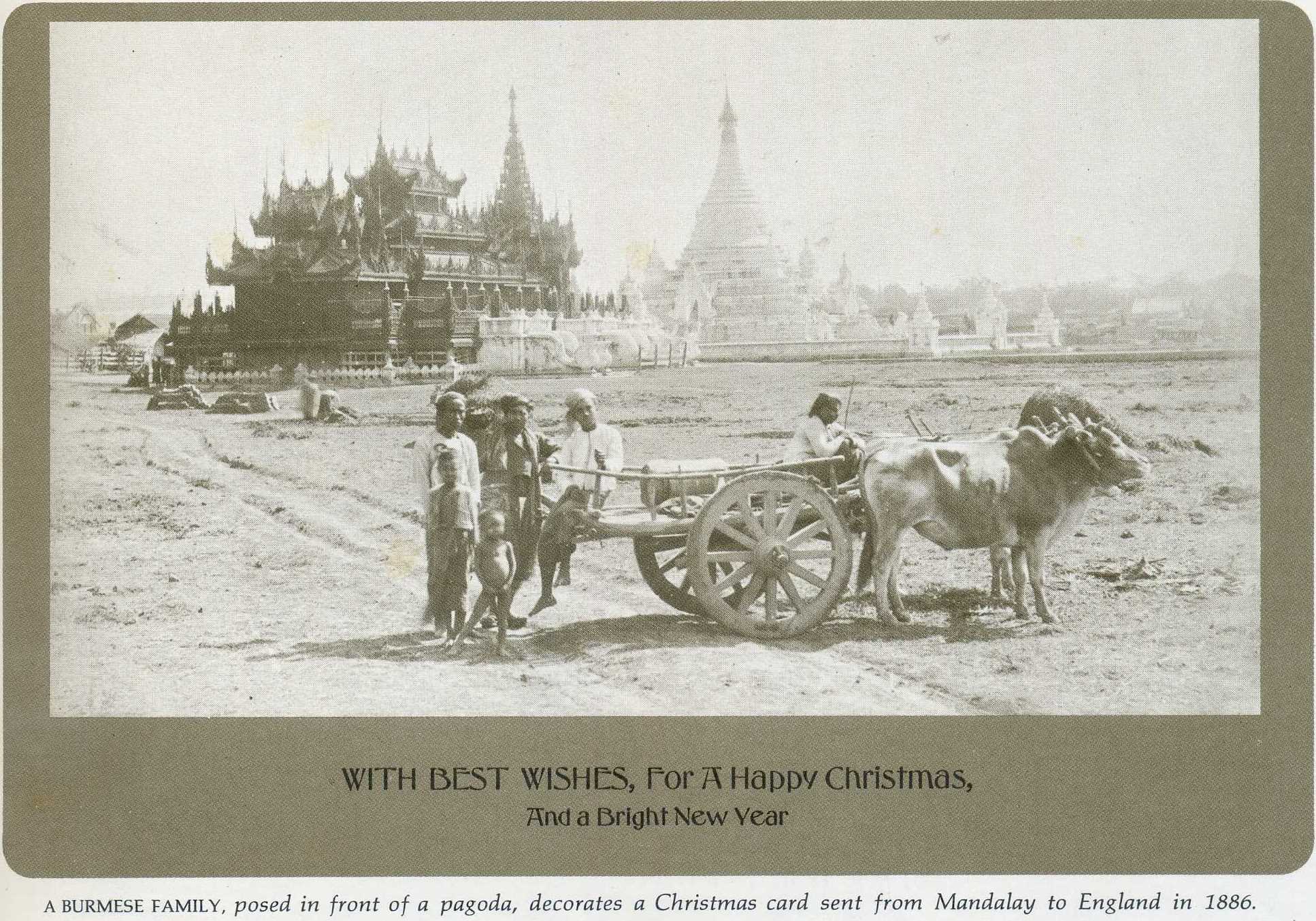
Finally, here is a Christmas card sent from Mandalay in 1886.
Do you think you would like to become a podcaster on Blubrry? Click here for the details on joining. Enter my promo code, HSEASIA, to let them know I sent you, and you will get the first month's hosting for free!
Support this podcast!
Episode 23, British Singapore, Malaya, and Borneo
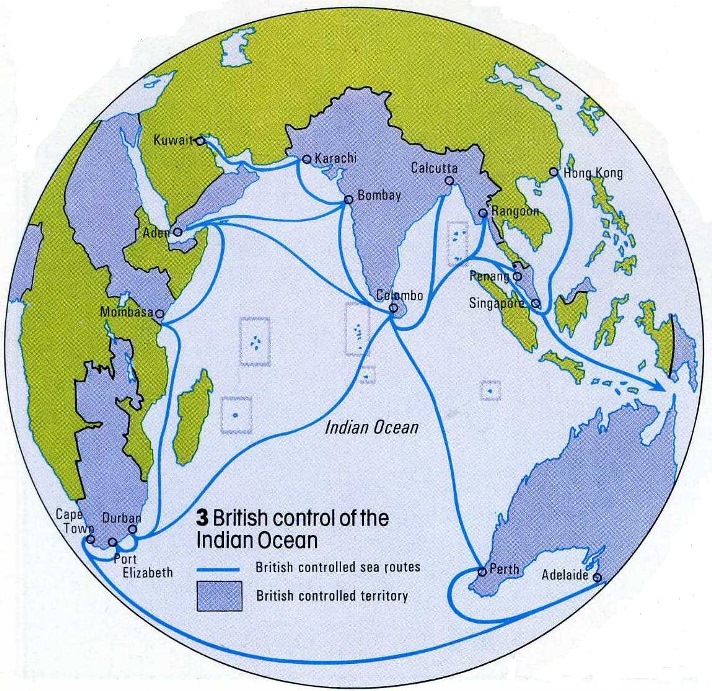
This episode calls the Indian Ocean a "British lake." Here you can see what I meant by that; Britain ruled all the purple territories in 1914.
Do you think you would like to become a podcaster on Blubrry? Click here for the details on joining. Enter my promo code, HSEASIA, to let them know I sent you, and you will get the first month's hosting for free!
Support this podcast!
Episode 22, The Dutch East Indies
Do you think you would like to become a podcaster on Blubrry? Click here for the details on joining. Enter my promo code, HSEASIA, to let them know I sent you, and you will get the first month's hosting for free!
Support this podcast!
Episode 21, A Second Introduction
Do you think you would like to become a podcaster on Blubrry? Click here for the details on joining. Enter my promo code, HSEASIA, to let them know I sent you, and you will get the first month's hosting for free!
Support this podcast!
Episode 20, Eighteenth Century Burma & Siam
Do you think you would like to become a podcaster on Blubrry? Click here for the details on joining. Enter my promo code, HSEASIA, to let them know I sent you, and you will get the first month's hosting for free!
Support this podcast!
Episode 19, The First Two Divisions of Vietnam
This map from Wikipedia shows Vietnam around 1650, in the middle of the second division. The lands belonging to all the players mentioned in this episode are shown here. The Bau Lords are not mentioned because they were the least important faction; all they did was keep their district in the northwest independent of the other families, from 1527 until 1699.
Do you think you would like to become a podcaster on Blubrry? Click here for the details on joining. Enter my promo code, HSEASIA, to let them know I sent you, and you will get the first month's hosting for free!
Support this podcast!
Episode 18, Arakan and All That
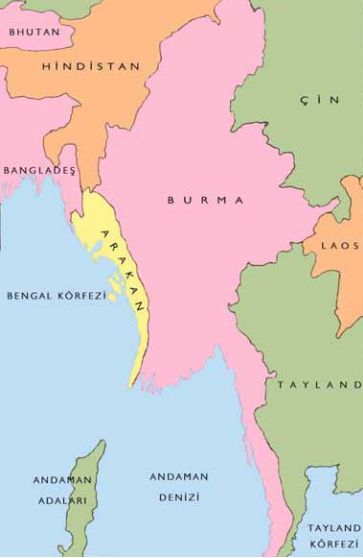
Here is the map that was originally posted in Episode 5, showing where Arakan/Rakhine is, in relation to the rest of Burma/Myanmar and Bangladesh.
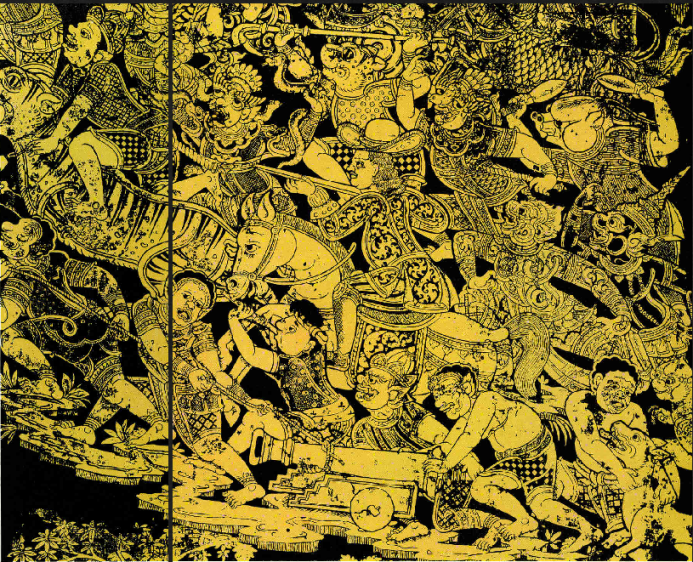
This picture is from the March 1971 issue of National Geographic Magazine, and it shows a lacquer panel painting, made in Siam during the eighteenth century. Here is a scene from a Buddhist legend, which shows the enemies of the Buddha attacking. Note the European in the middle of the crowd, taking aim with a musket. Listen to the episode to get an idea on why the artist thought Europeans were the bad guys.
Do you think you would like to become a podcaster on Blubrry? Click here for the details on joining. Enter my SEASIA, to let them know I sent you, and you will get the first month's hosting for free!
Support this podcast!
Episode 17, The Dutch East India Company
Do you think you would like to become a podcaster on Blubrry? Click here for the details on joining. Enter my promo code, HSEASIA, to let them know I sent you, and you will get the first month's hosting for free!
Support this podcast!
Episode 16, The Elephant Wars, Part 2
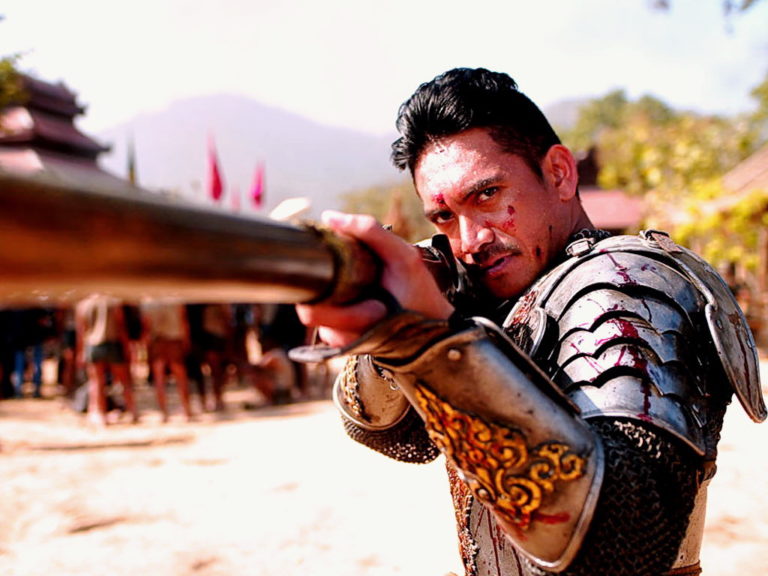
Here is the scene from "The Legend of King Naresuan" movie series where Naresuan shoots a Burmese general at long range, something you shouldn't be able to do with a sixteenth-century musket. An army officer, Wanchana Sawatdee, was picked to play the king, so Thai audiences would not get distracted by seeing a famous actor.
Do you think you would like to become a podcaster on Blubrry? Click here for the details on joining. Enter my promo code, HSEASIA, to let them know I sent you, and you will get the first month's hosting for free!
Support this podcast!
Episode 15, The Elephant Wars, Part 1
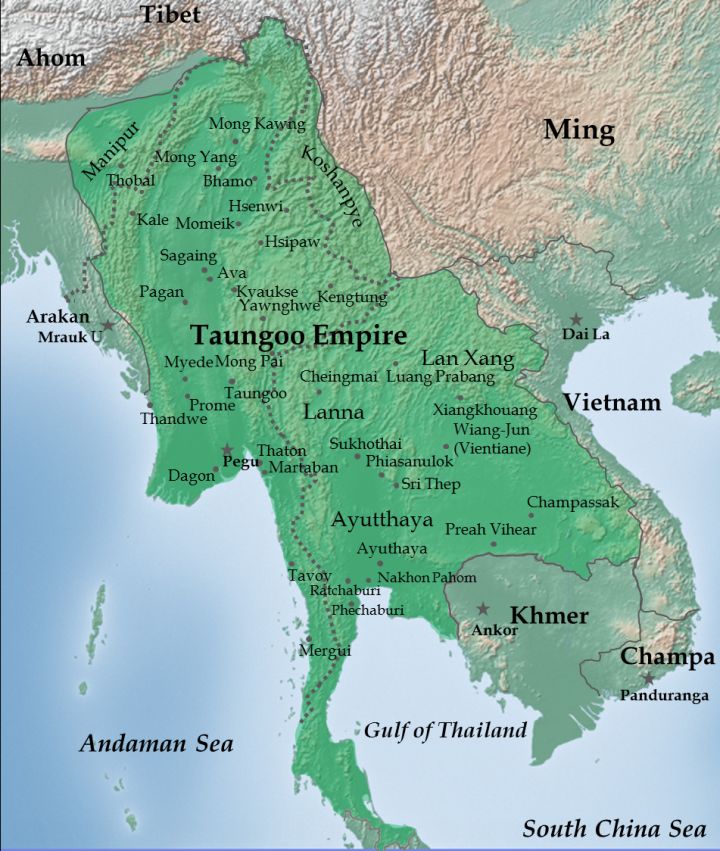
Here is the map from Wikipedia showing the second Burmese Empire in 1580, at the height of Bayinnaung's power. Unfortunately it has a few misspelled names, but I have not found a better map anywhere else.
Do you think you would like to become a podcaster on Blubrry? Click here for the details on joining. Enter my promo code, HSEASIA, to let them know I sent you, and you will get the first month's hosting for free!
Support this podcast!
Episode 14, The Spanish Philippines
(Note: A remastered edition of this episode was uploaded on March 24, 2017, with better sound quality than the original.)
.png)
Here is a map of the Philippines so listeners can keep track of all the places mentioned in this episode, from Manila to Mindanao.
Do you think you would like to become a podcaster on Blubrry? Click here for the details on joining. Enter my promo code, HSEASIA, to let them know I sent you, and you will get the first month's hosting for free!
Support this podcast!
Episode 13, Magellan's Not-so-excellent Adventure
In this episode, a second European nation, Spain, gets involved in Southeast Asia by discovering the Philippines, a part of Southeast Asia that had not gotten much attention previously. Then we will see Spain's attempts to take Indonesia and its valuable spice trade from Portugal.
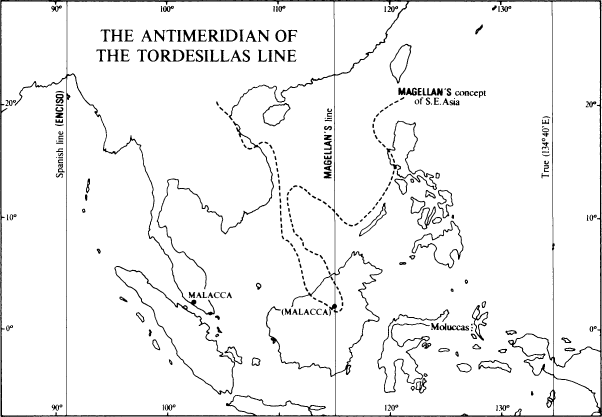
This map explains the Portuguese-Spanish dispute in Southeast Asia. It shows three ideas on where to put the "Tordesillas antimeridian," the line between the Portuguese and Spanish claims. Only the line on the right is in the correct place. The dotted line is where Ferdinand Magellan thought the Southeast Asian mainland was. Source: Stalemate at Bajadoz.
Do you think you would like to become a podcaster on Blubrry? Click here for the details on joining. Enter my promo code, HSEASIA, to let them know I sent you, and you will get the first month's hosting for free!
Support this podcast!
Episode 12, The Portuguese Trailblazers
This is the first episode of 2017, and the first episode covering events in the modern era. Here we will meet the Portuguese, the first Europeans to sail across the oceans in large numbers, see how they found Southeast Asia, and learn what they did in the region. With the European arrival, the rules of the game will change!
Do you think you would like to become a podcaster on Blubrry? Click here for the details on joining. Enter my promo code, HSEASIA, to let them know I sent you, and you will get the first month's hosting for free!
Support this podcast!
Episode 11, The Long Road From Mecca to Manila
There is one more major player in Southeast Asia to introduce before the Europeans arrive, and that player is Islam. This episode will focus on how Islam came to this part of the world, with special emphasis on Malacca, the first important Southeast Asian state that converted to the new religion.
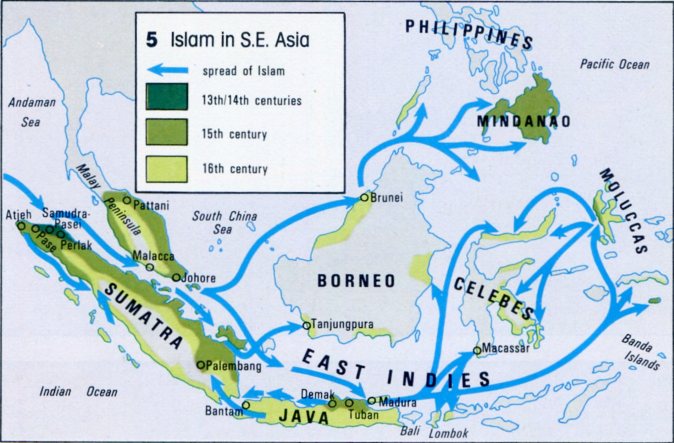
And here is a map showing how Islam spread across Southeast Asia, starting with Aceh (also spelled Acheh or Atjeh), from 1240 to 1600.
Do you think you would like to become a podcaster on Blubrry? Click here for the details on joining. Enter my promo code, HSEASIA, to let them know I sent you, and you will get the first month's hosting for free!
Support this podcast!
Episode 10, The Birth of Siam and Laos
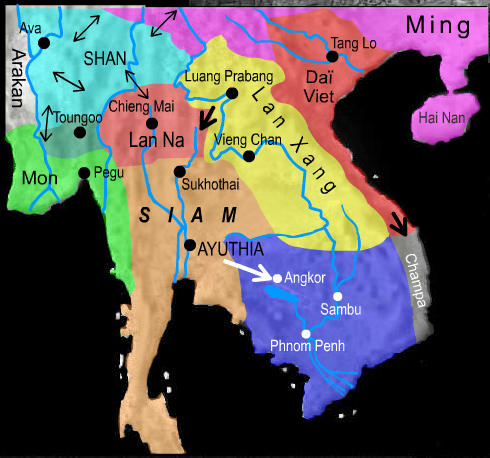
Here is a map of the Southeast Asian mainland, around 1530. All of the nations mentioned in this episode are shown, with arrows indicating the main conflicts. Vieng Chan is another name for Vientiane. Source: Angkor-planet.com.
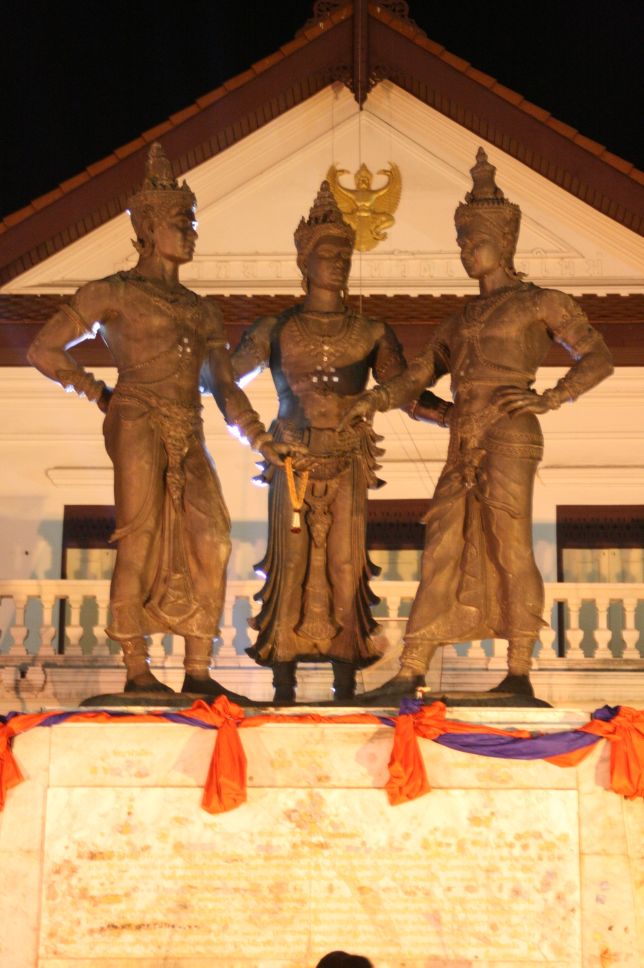
Thai kings got along well in the thirteenth century, so today in Chiangmai, Thailand, you can see the statues of three kings together. From left to right, these statues represent Ngam Muang (the ruler of a minor muang or city-state), Mangrai of Lan Na, and Ramkhamhaeng of Sukhothai. In 1287 these kings formed a friendship pact.
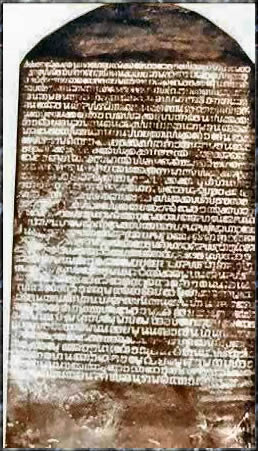
The Ramkhamhaeng stela. Click here for an English translation.
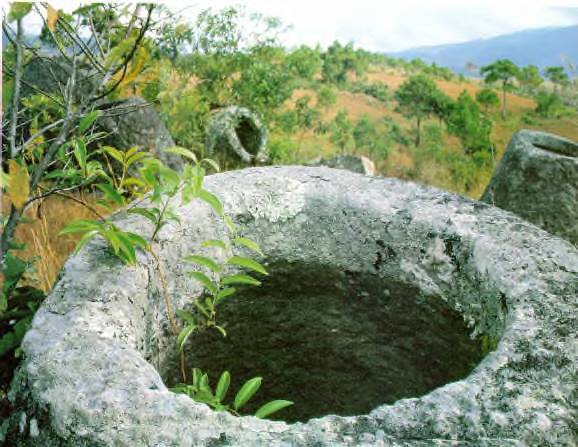
And here is one of the stone urns on the Plain of Jars.
Do you think you would like to become a podcaster on Blubrry? Click here for the details on joining. Enter my promo code, HSEASIA, to let them know I sent you, and you will get the first month's hosting for free!
Support this podcast!
Episode 9, The First Burmese Empire
This episode covers Burma (also called Myanmar) in the Middle Ages, with special emphasis on the Bagan Empire. Visit a city with more than 2,000 pagodas! Learn what makes Theravada Buddhism different from the other Buddhist sects. Meet a king who ruled for 95 years, and another king who ate 300 dishes of curry every day! Hear me mispronounce their names! It's all here for your listening pleasure!
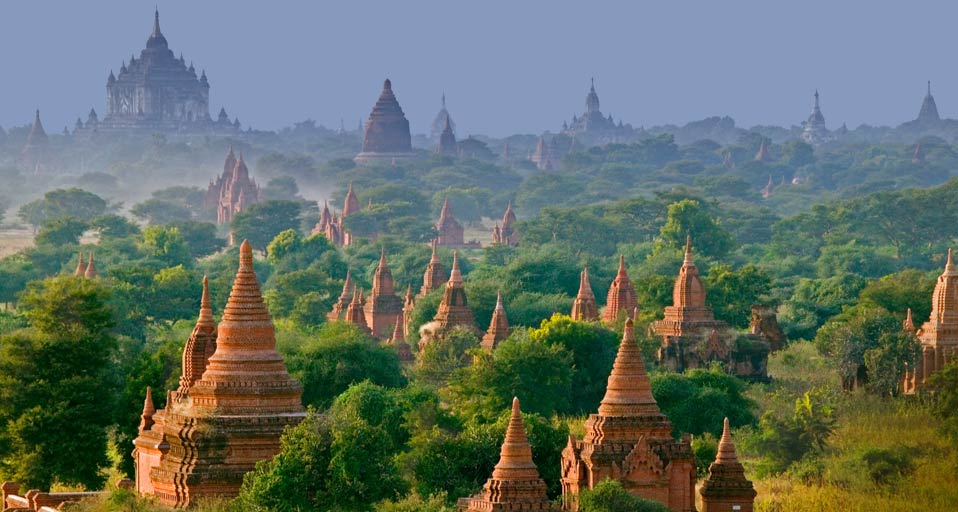
Here is part of the Bagan skyline, showing a few of its ruined pagodas.
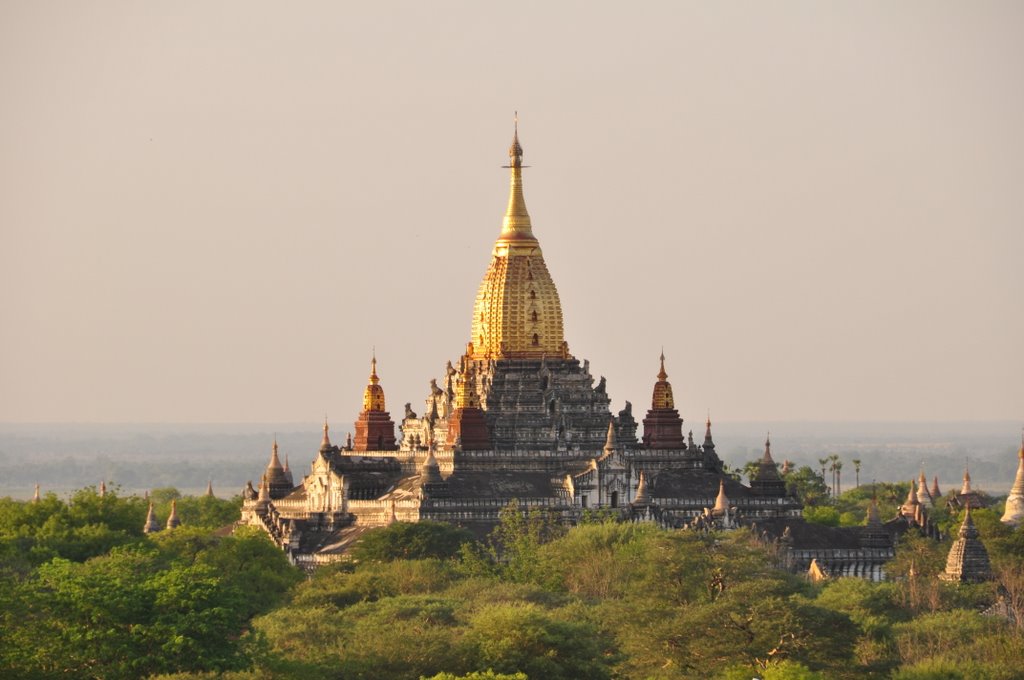 And here is Bagan's most spectacular building, the Ananda Temple.
And here is Bagan's most spectacular building, the Ananda Temple.
Finally, this graph shows how much land, workers and silver supported Burma's Buddhist clergy.
Do you think you would like to become a podcaster on Blubrry? Click here for the details on joining. Enter my promo code, HSEASIA, to let them know I sent you, and you will get the first month's hosting for free!
Support this podcast!
Episode 8, The Five Hundred Years War
This episode covers Vietnam from 939 to 1471. During this time two nations existed in the territory of present-day Vietnam (three if you count the Khmers ruling the Mekong delta). Those nations were the Vietnamese state, currently called Dai Viet, and the Indianized state of Champa. The Vietnamese and Chams fought on and off for most of this period, hence the episode name. Who won? Listen to find out!
(Note: A remastered edition of this episode was uploaded on February 1, 2017, to replace nearly three minutes of content that somehow had been cut out of the original.)
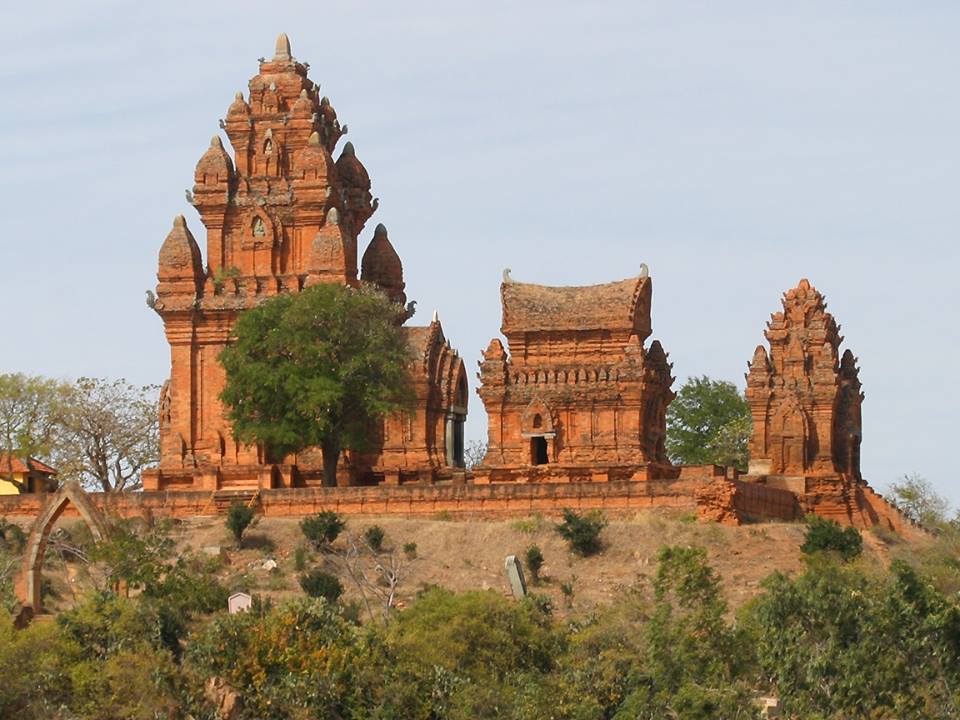
The main artifacts left to us by the Chams are Hindu temples made of bricks. Of these, the one in best shape is Po Klong Garai, built around 1300 by Jaya Sinhavarman III, near Phan Rang in southern Vietnam. Here it is.
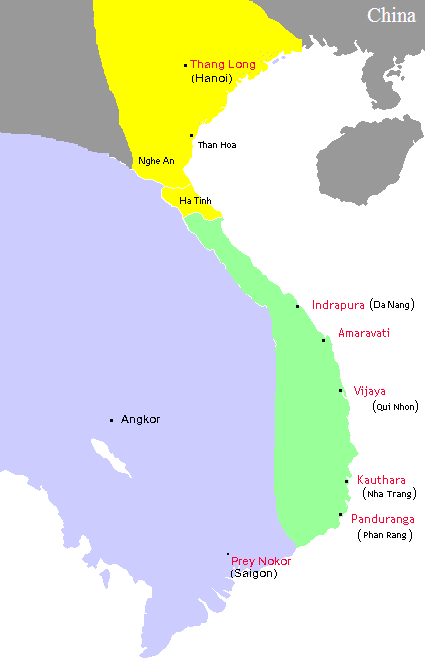
And here is a map of the area covered by this episode, around the year 1200. The Vietnamese kingdom is colored yellow, and Champa is colored green. Most of Champa’s cities are marked with two names: the original Sanskrit name in red, and the modern Vietnamese name in parentheses. To the left of both, in light blue, is the Khmer Empire, the nation featured in Episode 7.
Do you think you would like to become a podcaster on Blubrry? Click here for the details on joining. Enter my promo code, HSEASIA, to let them know I sent you, and you will get the first month's hosting for free!
Support this podcast!
Episode 7, The Khmers
We're now up to the most spectacular civilization in ancient/medieval Southeast Asia. This episode covers Cambodia from 550 to 1431, the golden age of the Khmers, ancestors of today's Cambodians. Here are some maps and pictures to give you a better idea of what I am talking about:
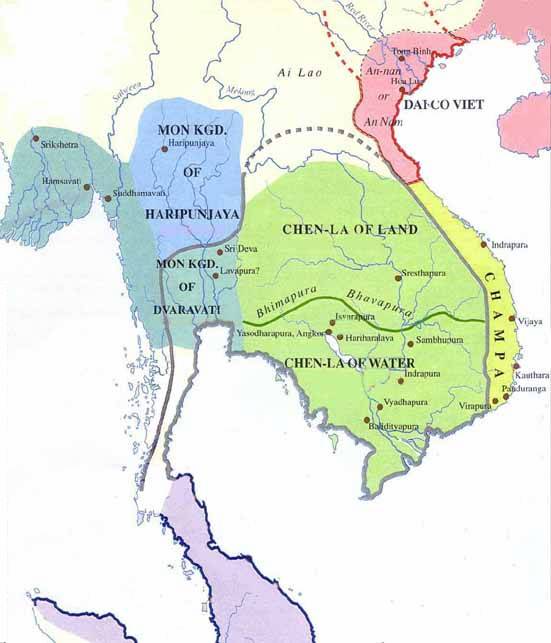
First, a map of mainland Southeast Asia, around 750 A.D. The violet-colored nation at the bottom is Srivijaya (see Episode 6).
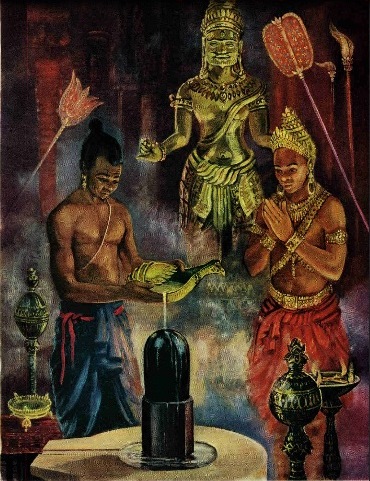
And here is Jayavarman II in the Devaraja (god-king) ceremony. The priest is annointing a lingam, a phallus-shaped stone representing Shiva; that was the most important image in the temple. From the April 1960 issue of National Geographic.
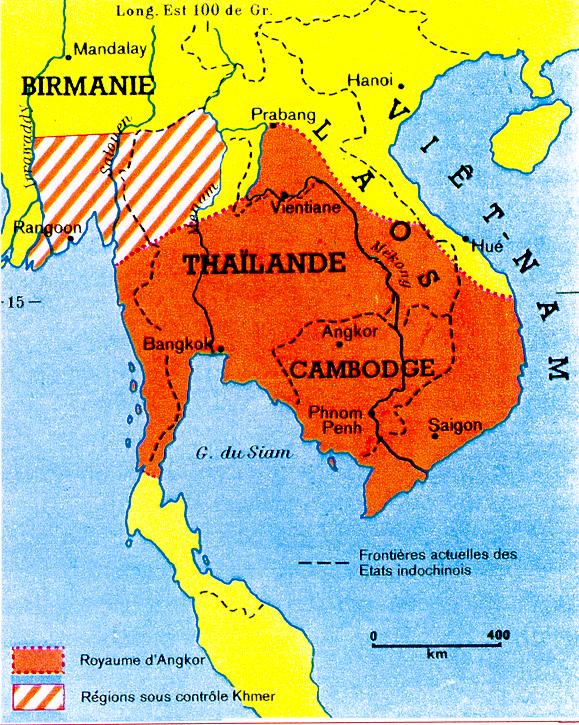
The Khmer Empire in the twelfth century. The striped area was ruled by the Burmese, but also claimed by the Khmers. From Angkorvat.net.
One of Angkor's gateways, with four faces of Jayavarman VII looking in different directions. In Ankgor, the phrase "Big Brother is watching you" was carved in stone!
Do you think you would like to become a podcaster on Blubrry? Click here for the details on joining. Enter my promo code, HSEASIA, to let them know I sent you, and you will get the first month's hosting for free!
Support this podcast!
Episode 6, Pre-Islamic Indonesia
This episode covers Indonesia from the year 600 to 1500, the years when historical records become available, but before most Indonesians converted to Islam (that will be a topic for a future episode). Five major kingdoms dominated the islands during this time: Srivijaya, Mataram, Kediri, Singosari, and Majapahit. Also, we will take a detailed look at Borobudur, Indonesia's greatest monument.
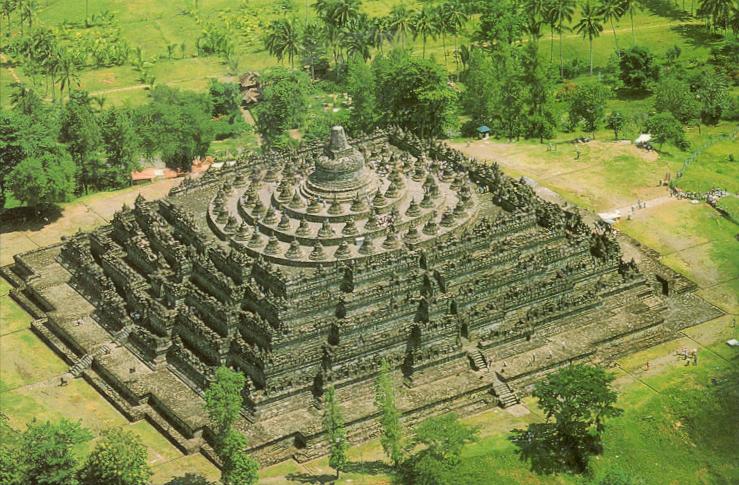
Here is a picture of Borobudur from the air, in case you want something to look at while following the description given in the episode.
On September 20, 2016, this podcast was accepted on Acast, the big Swedish podcasting host. I am happy about this because they said no three months earlier, when I applied before recording the first episode. For those keeping track, there are now five places where you can listen: Blubrry, iTunes, Stitcher, Google Play, and now Acast.
Do you think you would like to become a podcaster on Blubrry? Click here for the details on joining. Enter my promo code, HSEASIA, to let them know I sent you, and you will get the first month's hosting for free!
Support this podcast!
Episode 5, Ancient Burma and Nanzhao
For this episode, the main topic is how the nation of Burma, also called Myanmar, got started. We will see the Burmese and tribes related to them settle the north, and we will take a special look at Arakan, a province that often went its own way (see the map below).

Also in this episode, we will see the Mons, a tribe we met previously, move the capital of their state in southern Burma, from Thaton to Bago. Finally, we will meet Nanzhao, Burma's northern neighbor from the eighth to the thirteenth century.
And here is the website I recommended if you want to look at artifacts from the Pyu civilization:
https://www.pyukingdom.com
On September 7, 2016, this podcast was accepted on Google Play, probably the best download site on the World Wide Web. Now you have four places online where you can listen: Blubrry, iTunes, Stitcher, and Google Play.
Support this podcast!
Episode 4, Early Vietnam
This episode will focus on the east coast of the Southeast Asian mainland, going up to 938 A.D. This timeframe covers the beginning of two nations: Vietnam and Champa. Only one of them is around today; guess which one it is.
On August 30, 2016, this podcast was added to the programs available on Stitcher. Now if you have the Stitcher app on a mobile device, you have another way to listen!
http://www.stitcher.com/podcast/berosus/history-of-southeast-asia-podcast?refid=stpr
Support this podcast!
Episode 3, Mandalas
The first Southeast Asian nations larger than a city-state appeared in or near the first century A.D. In other words, roughly two thousand years ago. This episode will look at Funan, the major state that arose in Cambodia, and medium-sized states like Dvaravati, Haripunjaya, Pan Pan, Langkasuka, and Tambralinga, which the Mons and Malays founded in present-day Thailand and northern Malaya.
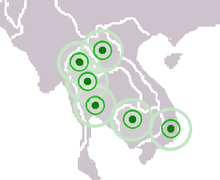
This map from Wikipedia shows the centers of political power on the Southeast Asian mainland in 1360 A.D. The episode refers to this map while explaining the loose monarchies that characterized Southeast Asian states in ancient times, a system we sometimes call "mandalas."
Support this podcast!
Episode 2, The Main Players Arrive
The Southeast Asians you are familiar with came originally from China, in at least five waves of migration: the Austronesians or Malays, the Mon-Khmers, the Vietnamese, the Tibeto-Burmans and the Thais. In this episode we will follow the Malay and Mon-Khmer migrations. Then when the Mons make contact with India, we will see Indian civilization introduced to nearly all of Southeast Asia, setting the stage for the rise of the first Southeast Asian states.
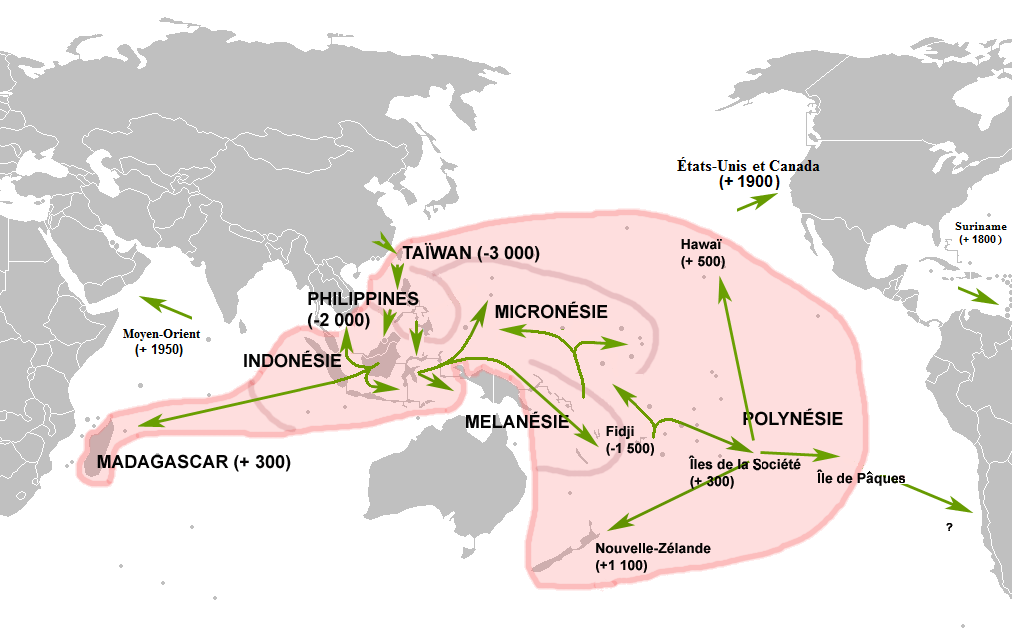
This map from Wikimedia Commons shows the path taken by the Austronesians during their great migration. Recent research has changed some of the dates, but otherwise the map is reliable.
Episode 1, The First Southeast Asians
Our narrative begins with Southeast Asia in prehistoric times. We will look at Java Man, Solo Man, Wadjak Man, Meganthropus, Gigantopithecus, Homo floresiensis, the Negritos, and the amazing Ban Chiang village in Thailand.
This episode was originally uploaded on July 15, 2016. It was edited on August 21 to remove a sentence that was later found to be in error.
Support this podcast!
Episode 0, Introduction
Meet the podcaster and get a geographical description of Southeast Asia, before jumping into the historical narrative that will make up the rest of this podcast series.
Support this podcast!
En liten tjänst av I'm With Friends. Finns även på engelska.